OLIVIA CHAMPAGNE
design work sample
04 10 18 20 24 30 34 40 STAY IN BOSTON HISTORIC CENTRE OF FLORENCE TYPOGRAPHY INFORMATION DESIGN GRAPHIC DESIGN ARTISTRY MAGAZINE BOSTON PUBLIC LIBRARY boston public library rest stop PLAYABILITY IN THE CITY TABLE OF CONTENTS
stay in boston
graphic design inquiry | prof. margarita barrios ponce | spring 2024
This semester-long project started by selecting a social cause I care about and considering factors such as the messaging, who the audience will be, and how the campaign will be rolled out across a location. While on co-op last fall I was introduced to multi-family housing and some of the challenges faced when proposing affordable housing projects in local communities, so I decided to focus on raising awareness of the lack of available and affordable housing in Greater Boston. After working with this broad topic for a few weeks, I decided to focus specifically on housing for young adults like myself who are drawn to the city for school and job opportunities, but struggle to afford to stay in Boston. This allowed me to narrow my audience to parents with children under 25, appealing to their relationship with their children and encouraging them to make a difference in their children’s future in the city. This campaign intends to encourage residents to be more aware of and supportive of new housing projects in their area while providing them with the resources to become more involved.
Displayed at bus stops, train stations, and on trash containers, the colorful signage transforms the displays to catch the attention of individuals on their way to and from work or their homes.
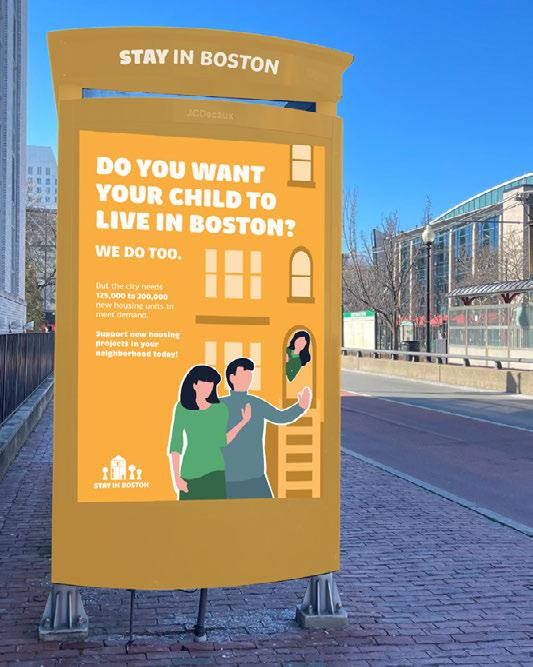
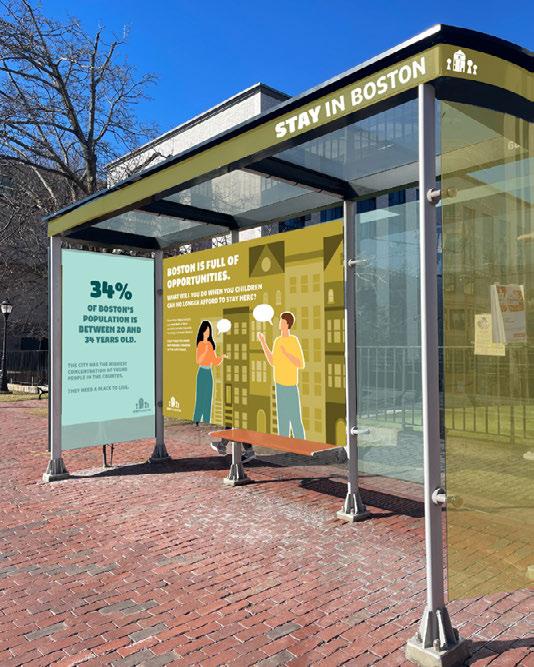
The style of the logo matches the rest of the campaign, a light and friendly feel that contrasts with more serious content. The home and figures are abstracted so they can apply to anyone, paired with the campaign name–inspired by the sentiment of young adults who want to stay in the city.
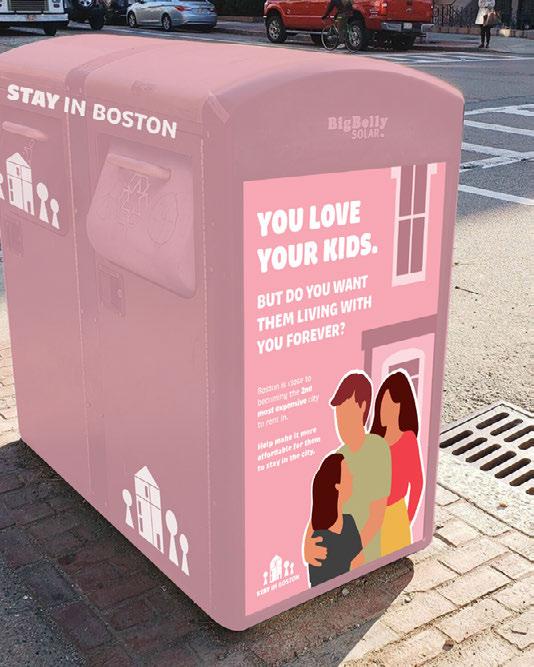
4
YOU
LOVE YOUR
KIDS.
BUT DO YOU WANT THEM LIVING WITH YOU FOREVER?

DO YOU WANT YOUR CHILD TO LIVE IN BOSTON?


This series, “On the Go,” consists of a set of three colorful posters, with illustrations of parents and their young adult children outside of apartments or homes at different levels of closeness. The text is bold and yet limited to a few key points, for individuals are likely not stopping for long and need to quickly understand what the campaign is advocating for.
5
Boston is close to becoming the 2nd most expensive city to rent in. Help make it more a ordable for them to stay in the city.
WHAT WILL YOU DO WHEN YOU CHILDREN CAN NO LONGER AFFORD TO STAY HERE? More than 1 in 4 renters pay over half of their monthly income towards housing in Greater Boston. Help push for more a ordable housing in the city today. OF BOSTON’S
IS BETWEEN 20 AND 34 YEARS OLD.
CITY HAS THE HIGHEST
YOUNG PEOPLE IN THE COUNTRY. THEY NEED A PLACE TO LIVE. 34%
BOSTON IS FULL OF OPPORTUNITIES.
POPULATION
THE
CONCENTRATION OF
WE DO TOO. But the city needs 125,000 to 200,000 new housing units to meet demand. Support new housing projects in your neighborhood today!
47%
OF RESIDENTS IN BACK BAY ARE BETWEEN 20 AND 34 YEARS OLD.
Of those young adults, many are forced to move to the suburbs or even out-of-state, unable to a ord to stay in Boston.
* Boston is close to becoming the 2ND MOST EXPENSIVE city for renters, with the median rent on a one-bedroom apartment being $2,720.
* One of the greatest obstacles to new, a ordable housing projects today is a lack of local support.
Do your part. Support new housing projects in your community.
What will you do when your children can no longer a ord to live here?
Learn more by visiting our website or checking out @stayinboston on Instagram!
57%
OF RESIDENTS IN MISSION HILL ARE BETWEEN 20 AND 34 YEARS OLD.
Of those young adults, many are forced to the suburbs or out-of-state, unable a ord to stay in
* More than 1 in 4 renters OVER HALF of their income toward housing Greater Boston.
* The median rent for bedroom apartment
* Gen Z can expect to $226,000 on rent in lifetimes.
Do your part. Support projects in your community.
What will you do your children can longer a ord to Learn our website out @stayinboston on Instagram!
6
adults, to move or even unable to Boston.
renters pay monthly housing in for a oneapartment is $2,720.
to pay close to in their new housing community.
do when can no live here?
more by visiting website or checking @stayinboston Instagram!
OF RESIDENTS IN THE NORTH END ARE BETWEEN 20 AND 34 YEARS OLD. 58%
Of those young adults, many are forced to move to the suburbs or even out-of-state, unable to a ord to stay in Boston.
* To meet demand by 2030, Greater Boston will need 125,000 to 200,000 new units of housing.
* Even with a rising population, the region has permitted less homes recently than it did back in the mid-1980s.
Do your part. Support new housing projects in your community.
What will you do when your children can no longer a ord to live here?
Learn more by visiting our website or checking out @stayinboston on Instagram!
The “Closer to Home” series consists of door hangers that will be delivered to individual homes and apartments in Greater Boston, with statistics specific to the neighborhood. The type, colors, and illustrations have a similar feel to the poster series, but the door hangers contain more information, with an eye-catching statistic and visual on the front paired with more details on the back about the cause and next steps. Delivered right to their doorstep, the individual can review the details of the campaign when it is convenient for them.
7
About Stay in Boston
What’s happening in your community?
One of the greatest obstacles to new and a ordable housing is a lack of local support.
Do your part. Support upcoming projects in your communty today.
Local Neighborhoods
Boston is close to becoming the 2nd most expensive city to rent in, making renting or buying a home increasingly out of reach for many. Stay in Boston is a campaign focused on raising awareness of the lack of available and a ordable housing for young adults in Greater Boston, especially for recent college graduates looking to continue living and working in the area.
Articles
When you can’t a ord to live in Boston, where do you go?
December 1, 2023
Business Insider
While young adults make up a significant portion of the city’s population, they also contribute to the economy, workforce and the livelihood of communities. Boston needs them to stay in the city. By sharing with residents the struggle faced by young adults, including their own children, this campaign hopes to call more attention to the issue, encouraging people to join the cause and advocate for more housing in their community.
Meet a Boston teacher who can't find an a ordable home in the city with the fastest-growing rent in the country:
February 6, 2o22
Globe
HOUSE, ONE FAMILY, AND THE FADING DREAM OF HOMEOWNERSHIP
October 25, 2023
your email address here
Back Bay
47% of residents in Back Bay are between 20 and 34 years old.
Of those young adults, many are forced to move to the suburbs or even out-of-state, unable to a ord to stay in Boston.
This website provides individuals with the resources necessary to accept the campaign’s call to action and advocate for more housing in their neighborhood. It is a larger resource with background on the campaign, articles that share the stories of young adults trying to live in Greater Boston, and a search bar that connects residents with proposed projects and upcoming meetings in their neighborhood.
8 Upcoming Meetings 2.15 Community Forum, 6:00-7:00pm at City Hall. 2.27 Vote being held for 20 Boylston St project. Come speak with the project developer and community leaders to learn more. 20 Boylston St 96,000 sf 54 units This project provides 40 units of workforce hosuing and 14 units of a ordable housing for families. The site is within walking distance to bus and commuter rail services.
Enter your neighborhood
zip code to get started
or
About Us Neighborhoods Resources Stories GET INVOLVED TODAY! STAY IN BOSTON
End Mission Hill
Allston Fenway Back Bay North
About Us Connect With Us Neighborhoods Resources Stories 123 Huntington Avenue Boston, MA 02115 617-224-3987 about@stayinboston.com YOU LOVE YOUR KIDS. BUT DO YOU WANT THEM LIVING WITH YOU FOREVER?
Want these
more
your
or to
articles and
sent to
inbox,
stay in touch?
Boston Globe
Boston
ONE
Enter
The campaign book contains all of the information about Stay in Boston and each visual series. I follow the same color palette and illustrative style of my other design implementations, with the typeface Brevia used throughout. Each section of the book (strategy, brand elements, campaign) follows a dual color theme, first introduced with a color page that has an illustration paired with bold statistics related to the cause. I decided to add quotes from young adults on the pages without illustrations, and I went through many iterations of how the impactful messaging would be represented visually.
“This
LOCATION
COLOR PALETTE
she said.
Kate, 29
ROLLOUT
9
10 11
While many cities across the United States find themselves without enough housing to keep up with their growing population, this campaign is specific to the city of Boston. The messaging provides statistics relevant to residents in the Greater Boston area and design implementations spread out across local neighborhoods. Stay in Boston intends to reach as many residents as possible through signage that will be passed by many, alongside promotional materials delivered right to their doorstep. Once successful, the campaign platform can be expanded for implementation in other large cities throughout the country.
The rollout for this campaign is divided into two parts, signage interventions along popular routes of transportation and door hangers delivered to individual homes. With bold and colorful signage adorning bus stops, train stations, and trash containers, there will be many opportunities to catch the attention of people on their way to and from work. These messages are intended to be brief and make individuals aware that the cause exists, but more information will be introduced in the form of door hangers that arrive on their doorsteps. This targets the individual and allows them to review details of the campaign when it is more convenient. Both of these interventions will refer people to a website that connects them with project proposals and upcoming meetings in their neighborhood, opportunities to become more involved and advocate for the cause in their community. The website will also serve as a resource for background on the campaign and to find articles with more information and personal accounts.
some ways,
resigned to the possibility that I may have to rent forever if I choose to live here.”
“In
I’m
might sound so depressing, but I truly cannot wrap my head around when I’ll ever be able to buy a home. It just feels so unattainable right now,”
than 1 in 4 renters pay OVER HALF of their monthly income toward housing in Greater Boston. Gen Z can expect to pay close to $226,000 on rent in their lifetimes. 12 Logo 13 Typefaces 14 Color Palette 16 Imagery 18 Messaging 19 Call to Action BRAND ELEMENTS 14 15
More
This campaign utilizes two main color palettes alongside white, one for all of the backgrounds and text elements, and another for the buildings within the illustrations. Both are bright and colorful, meant to catch the audience’s eye and invite people in to learn what the campaign is about. Like the typeface used, the color palette lightens the mood of the campaign and acts to encourage people, all while addressing a complicated social cause. The bus stop signage and the door hangers rely on residents wanting to interact with the design interventions amongst everything else going on around them, and color is an excellent way to make sure the messaging is welcoming and stands out. #42B677 #ED833A #ACDED5 #005456 71.512 M 1.87 71.85 K 0 #F7A7B4 #FFC228 C 3.310 M 59.68 Y 86.36 K C 31.72 M Y 18.09 K C 92.1 M 48.89 Y 56.78 K 32.16 C 0.310 M 12.52 Y 43.37 K C 1.321 M 92.92 Y 25.29 K 0 #B7A137 #9CC4BC C 30.51 M 30.58 Y 96.66 2.24 C 39.69 M 9.47 Y 26.92 K 0 C 12.98 M 66.17 Y 90.81 K 1.82 C 0.3 M 34.78 Y 84.57 K 0 #D47035 #FBAF40 C 0 M 70.59 Y 84.55 K C 0.8 M 15.73 Y 8.88 K 0 #F36F3B #FADCD8
the historic centre of florence
graphic design synthesis | prof. douglass scott | spring 2024
Another semester-long project I worked on involved developing an identity system for a UNESCO World Heritage Site. After studying abroad last summer in Italy, I was eager to work with the Historic Centre of Florence and try to represent the city through typography and visual elements. During the first few weeks of the semester, I worked to develop a mark and logotype, after compiling a wordlist including key features of the site. I decided to use an outline of the dome of the Florence Cathedral, one of the most well-known features of the city, also cut out from the letter “o” in Florence. Italy has a rich historical context, complemented by the use of Caslon for the typeface where a sans serif is not needed for improved readability. Producing so many deliverables allowed me to flesh out a well-developed visual system for the letterhead and envelope, business card, and website homepage that could also be applied to a series of advertisements in the New Yorker and a delivery van. Perhaps the most challenging tasks were bringing together two separate texts in a booklet about the site alongside photographs, and running through iterations for a three-dimensional site sign that would feature text in seven different languages for visitors. I found developing a pattern for my fifth element and a simple color palette essential for bringing each piece together in my visual summary.
Cathedral Dome Palace Baptistry
Bell Tower Galleries Archways Columns Plazas
Arno River Sculpture
Fountain
Bridges Garden Marble Brick Cobblestone Pattern
Ornamentation
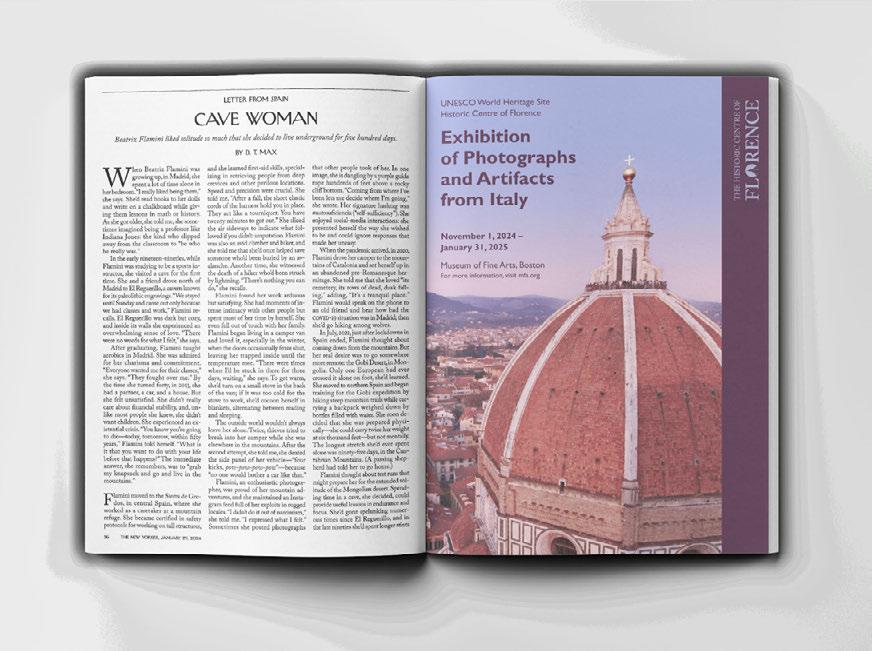
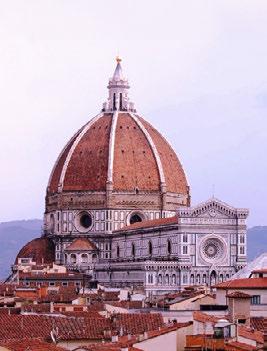
A visual summary that I printed at the end of the semester, which contains all of the deliverables developed for the identity of the Historic Centre of Florence.

10
THE NOMINATION PROCESS Only countries that have signed the World Heritage Convention, pledging protect there natural and cultural heritage, can submit nomination proposals for properties on their territory be considered for inclusion UNESCO’s World Heritage List. Heritage List, sites must be outstanding universal value and meet at least one out of ten selection criteria.These criteria are explained the Operational Guidelines for the Implementation of the World Heritage Convention which, besides the text the Convention, the main working tool on World Heritage.The criteria are regularly revised by the Committee to reflect the evolution of the World Heritage concept itself. Until the end of 2004, World Heritage sites were selected on the basis six cultural and four natural criteria.With the adoption of the revised Operational Guidelines for the Implementation the World Heritage Convention, only one set of Selection criteria: (i) represent masterpiece human creative genius; (ii) exhibit an important interchange of human values, over span time or within cultural area the world, on developments in architecture or technology, monumental arts, townplanning, or landscape design; (iii) bear unique exceptional testimony living or which (iv) be an outstanding type of building, technological ensemble which illustrates stage(s) in human (v) be an outstanding traditional human land-use, or sea-use representative cultures), or human the environment has become vulnerable impact irreversible (vi) be directly with events or with ideas, or The Basilica Santa Croce where you can admire the funerary monuments of important people like Galileo Galilei, Niccolò Machiavelli and Michelangelo. Once you’ve crossed the Ponte Vecchio, you’ll find yourself the Oltrarno area, home historic artisan shops, where craftsmen still use traditional techniques to produce their high-quality products. While in Florence, don’t forget visit Palazzo Strozzi, Palazzo Pitti, Boboli Gardens and the Church Santa Maria Novella, near the train station. Piazzale Michelangelo entire city (go there the sunset). Florence is an international mecca for culture, the city is truly oneof-a-kind! OLIVIA CHAMPAGNE NEU 2024

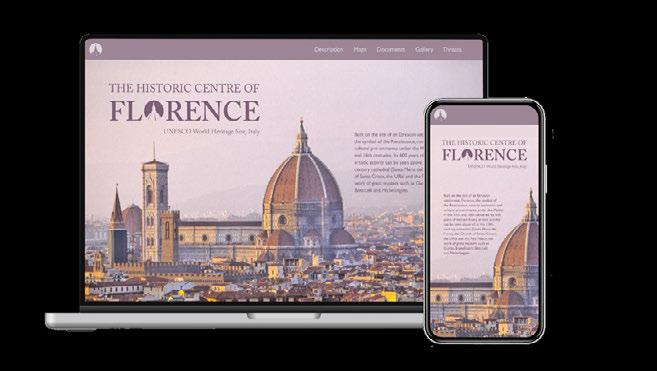




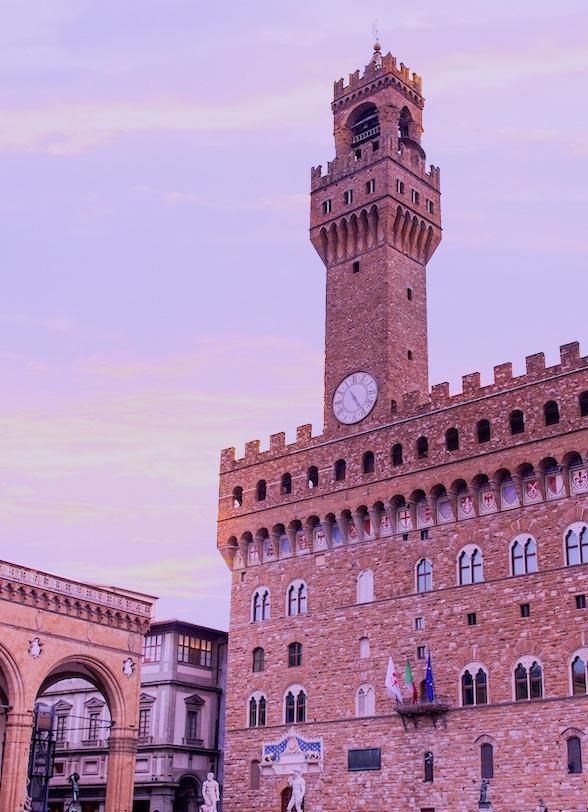
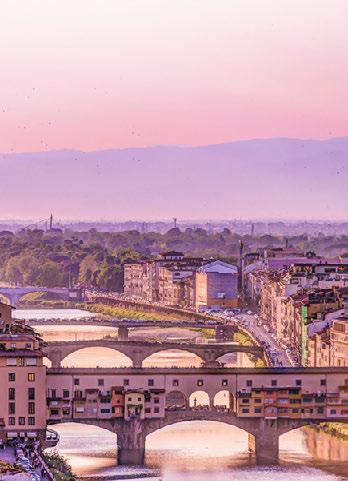

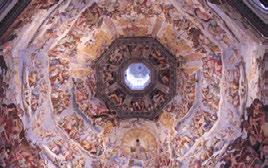

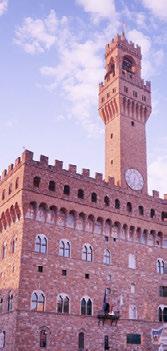
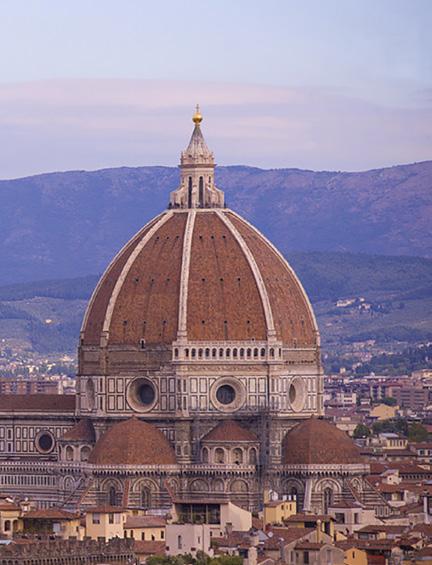









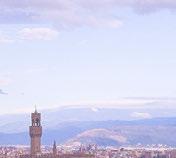
1. The Historic Centre of Florence contains many historic cathedrals, museums, and plazas to visit, and a centralized information center in Piazza del Duomo will provide visitors with access to maps, ticket information, and guided tours for points of interest across the city. This will help streamline the visitor experience and allow people to learn about more than just the most popular tourist attractions.
2. Additional site signs will be established around Florence, as well as maps and directional signs to point visitors to points of interest near them, promoting exploration of the city and a greater understanding of its rich history. Signage outside specific buildings such as cathedrals will provide background before one enters the building.
3. Distribution of promotional materials will further establish the Historic Centre of Florence’s identity and role as a trusted source of information about the site, committed to protecting and sharing the city’s history with others. Frequently coming into contact with the mark and logotype across printed materials and merchandise will let people know who to contact to learn more about the site.

SITES IN DANGER Armed conflict and war, earthquakes and other natural disasters, pollution, poaching, uncontrolled urbanization and unchecked tourist development pose major problems to World Heritage sites.These can threaten the very characteristics for which site was originally inscribed on the World Heritage List. Dangers can ‘ascertained’, referring specific and proven imminent threats, or ‘potential’, when property faced with threats which could have negative effects on its World Heritage values. Bamiyan Valley in Afghanistan This cultural landscape was inscribed on the List World Heritage Danger 2003 simultaneously with its inscription on the World Heritage List.The property in fragile state of conservation considering that has suffered from abandonment, military action and dynamite explosions. Parts of the site are inaccessible due the presence antipersonnel mines. UNESCO, the request of the Afghan Government, coordinates all international efforts safeguard and enhance Afghanistan’s cultural heritage, notably Bamiyan. City of Bam in the Islamic Republic Iran The ancient Citadel and surrounding cultural landscape the Iranian city of Bam, where 26,000 people lost their lives the earthquake December 2003, was simultaneously inscribed on UNESCO’s World Heritage List and on the List World Heritage in Danger in 2004. Important international efforts are mobilized salvage the cultural heritage this devastated city. Kathmandu Valley in Nepal The exceptional urban and architectural heritage Kathmandu, Patan and Bhaktapur has been severely affected by uncontrolled urban development.The property composed of seven Monument Zones, which, since the time inscription 197, have unfortunately been seriously altered, resulting in general loss authenticity and integrity of the property as World Heritage Danger in 2003. UNESCO working with the Nepalese authorities to help them develop long-term management plan conserve the remaining World Heritage values the property and adopt corrective measures address illegal building activities. OUTSTANDING UNIVERSAL VALUE Brief synthesis an Etruscan settlement and the later ancient Roman colony of Florentia (founded in 59 BC). This Tuscan city became symbol of the Renaissance during the early Medici period (between the 15th and the 16th centuries), reaching extraordinary levels economic and cultural development. The present historic centre covers 505 ha and bounded by the remains of the city’s 14th-century walls. These walls are represented surviving gates, towers, and the two Medici strongholds: that of Saint John the Baptist the north, popularly known “da Basso”, and the Fort of San Giorgio del Belvedere located amongst the hills of the south side. The Arno River runs east and west through the city and series bridges connects its two banks including Ponte Vecchio and Ponte Santa Trinita. Seven hundred years cultural and artistic blooming are tangible today in the 14th-century Cathedral of Santa Maria del Fiore, the Church of Santa Croce, the Palazzo Vecchio, the Uffizi gallery, and the Palazzo Pitti. The city’s history further evident in the artistic works of great masters such as Giotto, Brunelleschi, Botticelli and Michelangelo. HISTORIC CENTRE Description settlement, Florence, the symbol the Renaissance, rose economic and cultural pre-eminence under the Medici the 15th and 16th centuries. Its 600 years extraordinary artistic activity can be seen above all in the 13thcentury cathedral (Santa Maria del Fiore), the Church Santa Croce, the Uffizi and the Pitti Palace, the work of great masters such Giotto, Brunelleschi, Botticelli and Michelangelo. The Historic Centre of Florence can be perceived unique social and urban achievement, the result of persistent and long-lasting creativity, which includes museums, churches, buildings and artworks had an overwhelming influence on the development architecture and the fine arts, first in Italy, and then Europe. It within the context of Florence that the concept the Renaissance came to be. This heritage bestows upon Florence unique historical and aesthetic qualities. Palazzo Vecchio, the town hall the city ON THE LIST OF WORLD HERITAGE IN DANGER Olivia Champagne Graphic Designer Northeastern University 360 Huntington Avenue Boston, MA 02215 Dear Ms. Champagne, Thank you for reaching out to learn more about the Historic Centre Florence. My name Carlo Francini and am the Head of the “Florence World Heritage and Relations with UNESCO” Office of the Municipality of Florence and the site mananger for this particular site. We appreciate your interest and would be happy share bit more information about Florence and our mission. Florence served as symbol the Renaissance and was built on the site an Etruscan settlement.The city rose economic and cultural pre-eminence under the Medici in the 15th and 16th centuries, and its 600 years of extraordinary artistic activity can be seen above the 13th-century cathedral (Santa Maria del Fiore), the Church of Santa Croce, the Uffizi and the Pitti Palace, the work of great masters such Giotto, Brunelleschi, Botticelli and Michelangelo.The city’s rich history and variety of museums, churches, and other famous sites has made major tourist attraction and place to certainly visit within your lifetime. The Historic Centre of Florence can be perceived unique social and urban achievement, the result persistent and long-lasting creativity, which includes museums, churches, buildings, and artworks immeasurable worth. Florence had overwhelming influence on the development of architecture and the fine arts, first in Italy, and then in Europe. is within the context of Florence that the concept the Renaissance came to be.This heritage bestows upon Florence unique historical and aesthetic qualities. We provide several online resources as well as on-site information centers and tours guides to assist you with experiencing everything Florence has offer.Attached you will find booklet that includes photographs some the main sites and background about UNESCO’s mission. We seek to continue to preserve this historic center of the city and encourage others to do the same. Do not hesitate reach out to us again you or your university have any additional questions or require further information.We are always williing to help! Sincerely, Carlo Francini Site Manager Carlo Francini P: +39 055 2625441 E: firenzepatrimoniomondiale@comune.fi.it W: http://www.firenzepatrimoniomondiale.it/ UNESCO World Heritage Site Historic Centre of Florence Via Giuseppe Garibaldi Florence, Italy 50123 UNESCO World Heritage Site Historic Centre of Florence Via Giuseppe Garibaldi Florence, Italy 50123 Olivia Champagne 360 Huntington Avenue Boston, MA 02215 MISSION STATEMENT The United Nations Educational, Scientific and Cultural Organization (UNESCO) seeks to encourage the identification, protection and preservation cultural and natural heritage around the world considered to outstanding value to humanity. This is embodied international treaty called Convention concerning the Protection of the World Cultural and Natural Heritage, adopted by UNSECO 1972. Cultural heritage refers monuments, groups buildings archaeological, scientific, ethnological or anthropological value. Natural heritage refers to outstanding physical, biological and geological formations, habitats threatened species animals and plants and areas with scientific, conservation UNESCO’s World Heritage mission to: Encourage countries sign the World Heritage Convention and to ensure the protection their natural and cultural heritage; Encourage States Parties the Convention to nominate sites within their national territory for inclusion on the World Heritage List; Encourage States Parties establish management plans and set up reporting systems on the state conservation their World Heritage sites; Assist States Parties in safeguarding World Heritage sites by providing technical assistance and professional training; Provide emergency assistance for World Heritage sites immediate danger; Support States Parties’ public awareness-building activities for World Heritage conservation; Encourage participation the local population in the preservation their cultural and natural heritage; Encourage international cooperation the conservation our world’s cultural and natural heritage. Cathedral Santa Maria del Fiore, least testimony to cultural has disappeared; outstanding example of architectural or ensemble or landscape (a) significant history; outstanding example of human settlement, sea-use which culture (or human interaction with especially when vulnerable under the irreversible change; tangibly associated living traditions, with beliefs, with artistic and literary works outstanding universal significance. (The Committee considers that this criterion should preferably be used in conjunction with other criteria); (vii) contain superlative natural phenomena or areas exceptional natural beauty and aesthetic importance; (vii) be outstanding examples representing major stages of earth’s history, including the record of life, significant on-going geological processes the development of landforms, or significant geomorphic or physiographic features; (ix) be outstanding examples representing significant on-going ecological and biological processes the evolution and development of terrestrial, fresh water, coastal and marine ecosystems and communities plants and animals; (x) contain the most important and significant natural habitats for in-situ conservation biological diversity, including those containing threatened species outstanding universal value from the point of view of science or conservation. The protection, management, authenticity and integrity properties are also important considerations. Since 1992 significant interactions between people and the natural environment have been recognized as cultural landscapes. Ponte Vecchio, bridge connecting the city Florence’s centre home to outstanding historical treasures, which is why, 1982, UNESCO declared the area World Heritage Site. It’s not hard to agree with that decision: visit to piazza Duomo and you’ll be treated to incredible traces of the Renaissance, like the Cathedral of Santa Maria del Fiore built in typically Italian Gothic style and Giotto’s famed bell tower. The cathedral’s imposing dome, built Brunelleschi, remains an outstanding example of architectural genius. Washington, D.C., 1965 called for ‘World Heritage Trust’ protect ‘natural and scenic areas and historic sites.’ UNESCO spearheads international campaign save Venice after disastrous floods threatened the city. IUCN develops proposal similar to the ‘World Heritage Trust’ for its members. 1972 Following united Nations Conference on the Human 1972 and the work expert groups involving IUCN, ICOMOS and UNESCO, the proposals came together the Convention concerning the Protection World Cultural and Natural Heritage, which was adopted by the General Conference UNESCO Paris November 1972. on the World Heritage List. 1992 Marks the 20th Anniversary the World Heritage Convention, Heritage Centre, and the adoption the cultural landscapes category the World Heritage Committee, making the World Heritage Convention the first international legal instrument to recognize and protect cultural landscapes. A BRIEF HISTORY international campaign and collects US$80 million to save the Abu Simbel temples the Nile valley. draft the convention on the protection of cultural heritage prepared. 1962 UNESCO presents its Recommendation on the Safeguarding of the Beauty and Character Landscapes and Sites. preservation and the restoration of the aspect natural, rural and urban landscapes and sites, whether natural or man-made, which have cultural or aesthetic interest or form typical natural surroundings. The Global Strategy for Balanced and Representative World Heritage List adopted by the World Heritage Committee with the goal achieving better regional balance and greater thematic diversity the World Heritage List. encourages the nomination sites underrepresented parts of the world and especially categories which are not yet fully represented on the List. UNESCO launches the Young People’s participation in World Heritage Preservation and Promotion Project with the aim develop new educational approaches to mobilize young people becoming involved the protection and promotion of heritage. The United Nations proclaims 2002 The International Year for Cultural Heritage. 2002 mark the 30th anniversary of the World Heritage Convention, UNESCO, with the help of the Italian Government, organizes Venice the International Congress World Heritage: Shared Legacy, Common Responsibility, with the objective to assess the past 30 years implementation the World Heritage Convention and strengthen partnerships for World Heritage conservation. Next, head to Palazzo Medici Riccardi, the first Renaissance building in Florence, designed by Michelozzo. Not far, you’ll come across the Basilica San Lorenzo, commissioned by the Medici family to Brunelleschi. Its façade very atypical because it’s unfinished. Inside, the church home to works by Donatello and Michelangelo. famous pieces, visit the Accademia Gallery, where you can see Michelangelo’s David its magnificence. Just few steps away, piazza Santissima Annunziata and the Istituto degli Innocenti will fascinate you. DISCOVERING FLORENCE’S HISTORIC CENTRE Must-see gems one of the world’s most beloved cities Walking down via dei Calzaiuoli for shopping, you’ll arrive piazza della Signoria, the city’s historicalpolitical centre and home Palazzo Vecchio. Just around the corner, visit the Uffizi Gallery, where masterpieces Renaissance painting are beautifully collected. Frescoes covering the interior the dome designed by Brunelleschi (above). Walking down the aisle of the Cathedral of 20% 40% 60% 80% C 60.71 M 82.15 Y 43.52 K 34.35 #5C3652 10 ft 5 ft
UNESCO World Heritage Site Historic Centre of Florence For more information, visit mfa.org November 1, 2024 –January 31, 2025 Museum of Fine Arts, Boston Exhibition of Photographs and Artifacts from Italy UNESCO World Heritage Site Historic Centre of Florence For more information, visit mfa.org November 1, 2024 January 31, 2025 Museum of Fine Arts, Boston Exhibition of Photographs and Artifacts from Italy UNESCO World Heritage Site Historic Centre of Florence, Italy Built on the site an Etruscan settlement, Florence, the symbol of the Renaissance, rose economic and cultural pre-eminence under the Medici the 15th and 16th centuries. Its 600 years of extraordinary artistic activity can seen above all in the 13th-century cathedral (Santa Maria del Fiore), the Church of Santa Croce, the Uffizi and the Pitti Palace, the work great masters such Giotto, Brunelleschi, Botticelli and Michelangelo. The Historic Centre of Florence can be perceived as unique social and urban achievement, the result of persistent and long-lasting creativity, which includes museums, churches, buildings and artworks immeasurable worth. Florence had an overwhelming influence on the development of architecture and the fine arts, first in Italy, and then in Europe. is within the context of Florence that the concept the Renaissance came to be.This heritage bestows upon Florence unique historical and aesthetic qualities. Florence located within the Tuscan region Italy, and the Historic Centre spans across both sides of the Arno River. Information Guide P: +39 055 2625441 E: firenzepatrimoniomondiale@comune.fi.it W: http://www.firenzepatrimoniomondiale.it/ UNESCO World Heritage Site Historic Centre of Florence Via Giuseppe Garibaldi Florence, Italy 50123 Pitti Palace Basilica of Santa Maria Novella ARNO RIVER FLORENCE TUSCANY FLORENCE ITALY Cathedral of Santa Maria del Fiore Palazzo Vecchio Uffizi Gallery SPANISH ENGLISH CHINESE RUSSIAN ARABIC ITALIAN FRENCH
The outline of the cathedral dome serves as a mark of its own on the app icon and page watermarks, but it was also cut out of the “o” in Florence to create a trademarkable logotype.
I wanted the letterhead to have a formal and somewhat elegant feel. The design features a light outline of the dome that covers the lefthand side of the page, while the logotype and UNESCO site information are in color and aligned on the righthand side. This information is further distinguished from the body text of the letter with a change in typeface.
Olivia Champagne Graphic Designer
Northeastern University
360 Huntington Avenue Boston, MA 02215
Dear Ms. Champagne,
Thank you for reaching out to learn more about the Historic Centre of Florence. My name is Carlo Francini and I am the Head of the “Florence World Heritage and Relations with UNESCO” Office of the Municipality of Florence and the site mananger for this particular site. We appreciate your interest and would be happy to share a bit more information about Florence and our mission.
Florence served as a symbol of the Renaissance and was built on the site of an Etruscan settlement. The city rose to economic and cultural pre-eminence under the Medici in the 15th and 16th centuries, and its 600 years of extraordinary artistic activity can be seen above all in the 13th-century cathedral (Santa Maria del Fiore), the Church of Santa Croce, the Uffizi and the Pitti Palace, the work of great masters such as Giotto, Brunelleschi, Botticelli and Michelangelo. The city’s rich history and variety of museums, churches, and other famous sites has made it a major tourist attraction and a place to certainly visit within your lifetime.
The Historic Centre of Florence can be perceived as a unique social and urban achievement, the result of persistent and long-lasting creativity, which includes museums, churches, buildings, and artworks of immeasurable worth. Florence had an overwhelming influence on the development of architecture and the fine arts, first in Italy, and then in Europe. It is within the context of Florence that the concept of the Renaissance came to be. This heritage bestows upon Florence unique historical and aesthetic qualities.
We provide several online resources as well as on-site information centers and tours guides to assist you with experiencing everything Florence has to offer. Attached you will find a booklet that includes photographs of some of the main sites and background about UNESCO’s mission. We seek to continue to preserve this historic center of the city and encourage others to do the same.
Do not hesitate to reach out to us again if you or your university have any additional questions or require further information. We are always williing to help!
Sincerely,
Carlo Francini
Carlo Francini Site Manager
UNESCO World Heritage Site
Historic Centre of Florence
Via Giuseppe Garibaldi 7 Florence, Italy 50123
P: +39 055 2625441
E: firenzepatrimoniomondiale@comune.fi.it
W: http://www.firenzepatrimoniomondiale.it/
12
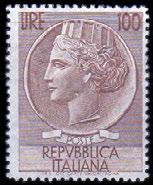
360 Huntington Avenue Boston, MA 02215
My business card is in the shape of the dome, with die-cut details at the top. The front utilizes sans serif type for improved legibility, while the back includes both the logotype and the pattern I developed as a fifth element for the envelope.
The envelope carries on many of the elements from the letterhead, but I added a pattern that will be revealed when the envelope is opened. Inspired by the marble facade of the Florence Cathedral, this enhances the design of certain pieces with additional color and detail.
P: 055 2625441 055 2625439
P: 055 2625441 / 055 2625439
13
Carlo Francini Site Manager
UNESCO World Heritage Site Historic Centre of Florence Via Giuseppe Garibaldi 7 Florence, Italy 50123
UNESCO World Heritage Site Historic Centre of Florence Via Giuseppe Garibaldi 7 Florence, Italy 50123
Olivia Champagne
Carlo Francini Site Manager
UNESCO World Heritage Site Historic Centre of Florence Via Giuseppe Garibaldi 7 Florence, Italy 50123
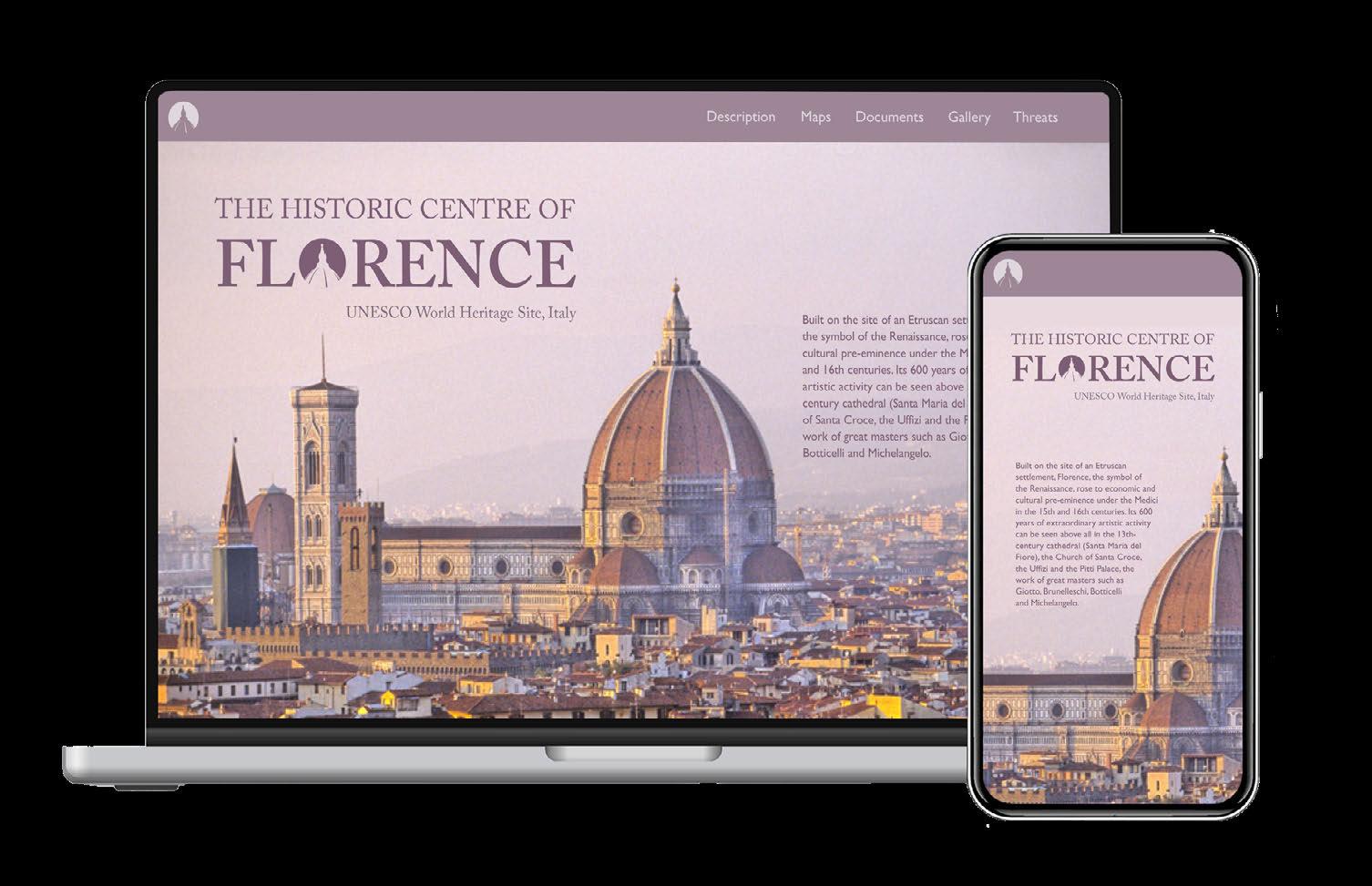
While my magazine advertisements each focus on an individual landmark in Florence, I wanted the website to convey the city as a whole, with its sprawling skyline. While the homepage needs to include links to pages with maps, photographs, and other information, I wanted the focus to be on a photograph and not an overwhelming amount of text on the page.
Each of my three advertisements features a different landmark in Florence, all photographs taken around sunset to appear more consistent. I continued to apply this color palette to the other deliverables going forward.

UNESCO World Heritage Site
Historic Centre of Florence
Exhibition of Photographs and Artifacts from Italy
November 1, 2024 –January 31, 2025
Museum of Fine Arts, Boston
For more information, visit mfa.org
14
My first iteration of posters used Caslon for all of the text, but I found it blended too much with the background. I rotated the logotype and moved it to a vertical band at the edge of the page while using Gil Sans for the remaining text with a stronger sense of hierarchy. The placement of the main text changes across the posters in response to the photographs, always aligned with the top of the logotype.

UNESCO World Heritage Site
Exhibition of Photographs and Artifacts from Italy
November 1, 2024 –January 31, 2025
Museum of Fine Arts, Boston
For more information, visit mfa.org

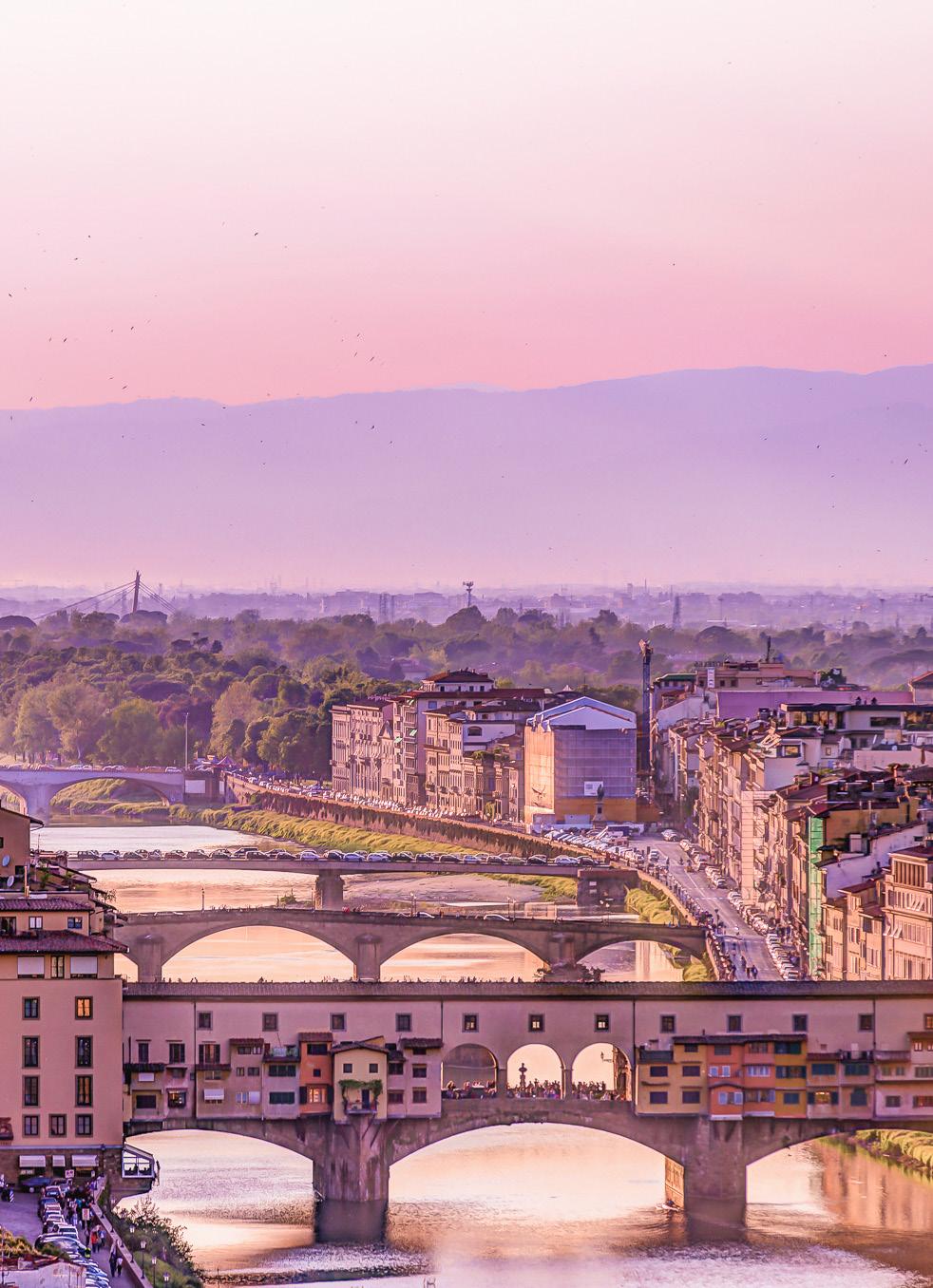
Exhibition of Photographs and Artifacts from Italy
November 1, 2024 –January 31, 2025
Museum of Fine Arts, Boston
For more information, visit mfa.org
15
Historic Centre of Florence
UNESCO World Heritage Site Historic Centre of Florence
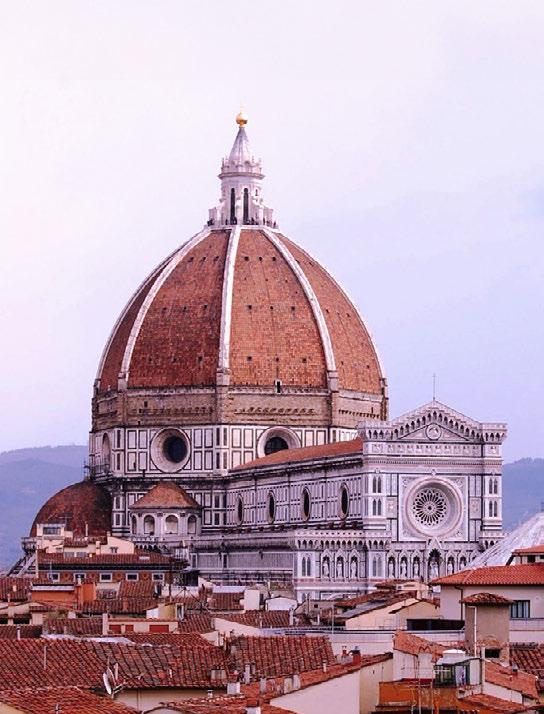
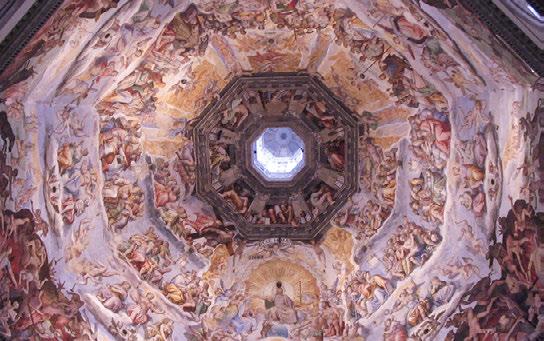

The two texts in the booklet are split between the top and bottom halves of the page, a different background color used for each. The typeface changes between serif and sans serif, with a dark purple tint for the top half and captions. Images of various scales and placement break up all the text.


16 2 1 MISSION STATEMENT The United Nations Educational, Scientific and Cultural Organization (UNESCO) seeks to encourage the identification, protection and preservation of cultural and natural heritage around the world considered to be of outstanding value to humanity. This is embodied in an international treaty called Convention concerning the Protection of the World Cultural and Natural Heritage, adopted by UNSECO in 1972. Cultural heritage refers to monuments, groups of buildings and sites with historical, aesthetic, archaeological, scientific, ethnological or anthropological value. Natural heritage refers to outstanding physical, biological and geological formations, habitats of threatened species of animals and plants and areas with scientific, conservation or aesthetic value. UNESCO’s World Heritage mission is to: · Encourage countries to sign the World Heritage Convention and to ensure the protection of their natural and cultural heritage; · Encourage States Parties to the Convention to nominate sites within their national territory for inclusion on the World Heritage List; · Encourage States Parties to establish management plans and set up reporting systems on the state of conservation of their World Heritage sites; · Assist States Parties in safeguarding World Heritage sites by providing technical assistance and professional training; · Provide emergency assistance for World Heritage sites in immediate danger; · Support States Parties’ public awareness-building activities for World Heritage conservation; · Encourage participation of the local population in the preservation of their cultural and natural heritage; Encourage international cooperation in the conservation of our world’s cultural and natural heritage. Cathedral of Santa Maria del Fiore, located in the center of the city. 2 Florence’s centre is home to outstanding historical treasures, which is why, in 1982, UNESCO declared the area a World Heritage Site. It’s not hard to agree with that decision: visit to piazza Duomo and you’ll be treated to incredible traces of the Renaissance, like the Cathedral of Santa Maria del Fiore - built in a typically Italian Gothic style and Giotto’s famed bell tower. The cathedral’s imposing dome, built by Brunelleschi, remains an outstanding example of architectural genius. 1965 A White House Conference in Washington, D.C., in 1965 called for a ‘World Heritage Trust’ to protect ‘natural and scenic areas and historic sites.’ 1966 UNESCO spearheads an international campaign to save Venice after disastrous floods threatened the city. 1968 IUCN develops a proposal similar to the ‘World Heritage Trust’ for its members. 1972 Following a united Nations Conference on the Human Environment in Stockholm, Sweeden, in 1972 and the work of expert groups involving IUCN, ICOMOS and UNESCO, all the proposals came together in the Convention concerning the Protection of World Cultural and Natural Heritage, which was adopted by the General Conference of UNESCO in Paris on 16 November 1972. 1978 First twelve sites are inscribed on the World Heritage List. 1992 Marks the 20th Anniversary of the World Heritage Convention, the creation of the UNESCO World Heritage Centre, and the adoption of the cultural landscapes category by the World Heritage Committee, making the World Heritage Convention the first international legal instrument to recognize and protect cultural landscapes. A BRIEF HISTORY 1959 UNESCO launches an international campaign and collects US$80 million to save the Abu Simbel temples in the Nile valley. A draft of the convention on the protection of cultural heritage is prepared. 1962 UNESCO presents its Recommendation on the Safeguarding of the Beauty and Character of Landscapes and Sites. This recommendation covers the preservation and the restoration of the aspect of natural, rural and urban landscapes and sites, whether natural or man-made, which have a cultural or aesthetic interest or form typical natural surroundings. 1994 The Global Strategy for a Balanced and Representative World Heritage List is adopted by the World Heritage Committee with the goal of achieving better regional balance and greater thematic diversity in the World Heritage List. It encourages the nomination of sites in underrepresented parts of the world and especially in categories which are not yet fully represented on the List. 1994 UNESCO launches the Young People’s participation in World Heritage Preservation and Promotion Project with the aim to develop new educational approaches to mobilize young people in becoming involved in the protection and promotion of heritage. 2002 The United Nations proclaims 2002 The International Year for Cultural Heritage. 2002 To mark the 30th anniversary of the World Heritage Convention, UNESCO, with the help of the Italian Government, organizes in Venice the International Congress World Heritage: Shared Legacy, Common Responsibility, with the objective to assess the past 30 years of implementation of the World Heritage Convention and to strengthen partnerships for World Heritage conservation. Next, head to Palazzo Medici Riccardi, the first Renaissance building in Florence, designed by Michelozzo. Not far, you’ll come across the Basilica of San Lorenzo, commissioned by the Medici family to Brunelleschi. Its façade is very atypical because it’s unfinished. Inside, the church is home to works by Donatello and Michelangelo. But as for Buonarroti’s most famous pieces, visit the Accademia Gallery, where you can see Michelangelo’s David in all its magnificence. Just few steps away, piazza Santissima Annunziata and the Istituto degli Innocenti will fascinate you. DISCOVERING FLORENCE’S HISTORIC CENTRE Must-see gems in one of the world’s most beloved cities Walking down via dei Calzaiuoli for shopping, you’ll arrive to piazza della Signoria, the city’s historicalpolitical centre and home to Palazzo Vecchio. Just around the corner, visit the Uffizi Gallery, where masterpieces of Renaissance painting are beautifully collected. Frescoes covering the interior of the dome designed by Brunelleschi (above). Walking down the aisle of the Cathedral of Santa Maria del Fiore. 4 5 THE NOMINATION PROCESS Only countries that have signed the World Heritage Convention, pledging to protect there natural and cultural heritage, can submit nomination proposals for properties on their territory to be considered for inclusion in UNESCO’s World Heritage List. THE CRITERIA FOR SELECTION To be included on the World Heritage List, sites must be of outstanding universal value and meet at least one out of ten selection criteria. These criteria are explained in the Operational Guidelines for the Implementation of the World Heritage Convention which, besides the text of the Convention, is the main working tool on World Heritage. The criteria are regularly revised by the Committee to reflect the evolution of the World Heritage concept itself. Until the end of 2004, World Heritage sites were selected on the basis of six cultural and four natural criteria. With the adoption of the revised Operational Guidelines for the Implementation of the World Heritage Convention, only one set of ten criteria exists. Selection criteria: (i) represent a masterpiece of human creative genius; (ii) exhibit an important interchange of human values, over a span of time or within a cultural area of the world, on developments in architecture or technology, monumental arts, townplanning, or landscape design; (iii) bear a unique or at least exceptional testimony to a cultural tradition or to a civilization which is living or which has disappeared; (iv) be an outstanding example of a type of building, architectural or technological ensemble or landscape which illustrates (a) significant stage(s) in human history; (v) be an outstanding example of a traditional human settlement, land-use, or sea-use which is representative of a culture (or cultures), or human interaction with the environment especially when it has become vulnerable under the impact of irreversible change; (vi) be directly or tangibly associated with events or living traditions, with ideas, or with beliefs, with artistic and literary works of outstanding universal significance. (The Committee considers that this criterion should preferably be used in conjunction with other criteria); (vii) contain superlative natural phenomena or areas of exceptional natural beauty and aesthetic importance; (vii) be outstanding examples representing major stages of earth’s history, including the record of life, significant on-going geological processes in the development of landforms, or significant geomorphic or physiographic features; (ix) be outstanding examples representing significant on-going ecological and biological processes in the evolution and development of terrestrial, fresh water, coastal and marine ecosystems and communities of plants and animals; (x) contain the most important and significant natural habitats for in-situ conservation of biological diversity, including those containing threatened species of outstanding universal value from the point of view of science or conservation. The protection, management, authenticity and integrity of properties are also important considerations. Since 1992 significant interactions between people and the natural environment have been recognized as cultural landscapes. The Basilica of Santa Croce is where you can admire the funerary monuments of important people like Galileo Galilei, Niccolò Machiavelli and Michelangelo. Once you’ve crossed the Ponte Vecchio, you’ll find yourself in the Oltrarno area, home to historic artisan shops, where craftsmen still use traditional techniques to produce their high-quality products. While in Florence, don’t forget to visit Palazzo Strozzi, Palazzo Pitti, Boboli Gardens and the Church of Santa Maria Novella, near the train station. Piazzale Michelangelo offers a beautiful view over the entire city (go there at the sunset). Florence is an international mecca for culture, the city is truly oneof-a-kind! Ponte Vecchio, bridge connecting the city across the Arno River. 9 LIST OF WORLD HERITAGE SITES IN DANGER Armed conflict and war, earthquakes and other natural disasters, pollution, poaching, uncontrolled urbanization and unchecked tourist development pose major problems to World Heritage sites. These can threaten the very characteristics for which a site was originally inscribed on the World Heritage List. Dangers can be ‘ascertained’, referring to specific and proven imminent threats, or ‘potential’, when a property is faced with threats which could have negative effects on its World Heritage values. Bamiyan Valley in Afghanistan This cultural landscape was inscribed on the List of World Heritage in Danger in 2003 simultaneously with its inscription on the World Heritage List. The property is in fragile state of conservation considering that it has suffered from abandonment, military action and dynamite explosions. Parts of the site are inaccessible due to the presence of antipersonnel mines. UNESCO, at the request of the Afghan Government, coordinates all international efforts to safeguard and enhance Afghanistan’s cultural heritage, notably in Bamiyan. City of Bam in the Islamic Republic of Iran The ancient Citadel and surrounding cultural landscape of the Iranian city of Bam, where 26,000 people lost their lives in the earthquake of December 2003, was simultaneously inscribed on UNESCO’s World Heritage List and on the List of World Heritage in Danger in 2004. Important international efforts are mobilized to salvage the cultural heritage of this devastated city. Kathmandu Valley in Nepal The exceptional urban and architectural heritage of Kathmandu, Patan and Bhaktapur has been severely affected by uncontrolled urban development. The property is composed of seven Monument Zones, which, since the time of inscription in 197, have unfortunately been seriously altered, resulting in a general loss of authenticity and integrity of the property as whole. For these reasons the site was inscribed on the List of World Heritage in Danger in 2003. UNESCO is working with the Nepalese authorities to help them develop a long-term management plan to conserve the remaining World Heritage values of the property and adopt corrective measures to address illegal building activities. OUTSTANDING UNIVERSAL VALUE Brief synthesis Florence was built on the site of an Etruscan settlement and the later ancient Roman colony of Florentia (founded in 59 BC). This Tuscan city became a symbol of the Renaissance during the early Medici period (between the 15th and the 16th centuries), reaching extraordinary levels of economic and cultural development. The present historic centre covers 505 ha and is bounded by the remains of the city’s 14th-century walls. These walls are represented by surviving gates, towers, and the two Medici strongholds: that of Saint John the Baptist in the north, popularly known as “da Basso”, and the Fort of San Giorgio del Belvedere located amongst the hills of the south side. The Arno River runs east and west through the city and a series of bridges connects its two banks including Ponte Vecchio and Ponte Santa Trinita. Seven hundred years of cultural and artistic blooming are tangible today in the 14th-century Cathedral of Santa Maria del Fiore, the Church of Santa Croce, the Palazzo Vecchio, the Uffizi gallery, and the Palazzo Pitti. The city’s history is further evident in the artistic works of great masters such as Giotto, Brunelleschi, Botticelli and Michelangelo. HISTORIC CENTRE OF FLORENCE Description Built on the site of an Etruscan settlement, Florence, the symbol of the Renaissance, rose to economic and cultural pre-eminence under the Medici in the 15th and 16th centuries. Its 600 years of extraordinary artistic activity can be seen above all in the 13thcentury cathedral (Santa Maria del Fiore), the Church of Santa Croce, the Uffizi and the Pitti Palace, the work of great masters such as Giotto, Brunelleschi, Botticelli and Michelangelo. The Historic Centre of Florence can be perceived as unique social and urban achievement, the result of persistent and long-lasting creativity, which includes museums, churches, buildings and artworks of immeasurable worth. Florence had an overwhelming influence on the development of architecture and the fine arts, first in Italy, and then in Europe. It is within the context of Florence that the concept of the Renaissance came to be. This heritage bestows upon Florence unique historical and aesthetic qualities.
hall
city
SOME ILLUSTRATIVE CASES OF SITES INSCRIBED ON THE LIST OF WORLD HERITAGE IN DANGER
Palazzo Vecchio, the town
of the
of Florence.
Guide
RIVER
FLORENCE
P: +39 055 2625441
E: firenzepatrimoniomondiale@comune.fi.it
W: http://www.firenzepatrimoniomondiale.it/

This mockup presents the scale and location for my three-dimensional site sign, an eight-sided structure shaped like a dome in the plaza beside the cathedral.
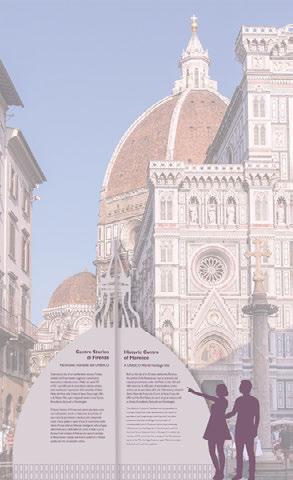
With so many historical sites in the city, I focused on labeling those featured within the booklet in the Historic Center and the Arno River on the larger map in the left column. I highlighted Florence’s position in the Tuscan region and Italy on small maps on the right, aligned with the site contact information. Unlike the letterhead, I included a dark band at the bottom of the page inspired by my New Yorker advertisements.

17 10 ft 5 ft 10 ft 5 ft 10 ft 5 ft Built on the site of an Etruscan settlement, Florence, the symbol of the Renaissance, rose to economic and cultural pre-eminence under the Medici in the 15th and 16th centuries. Its 600 years of extraordinary artistic activity can be seen above all in the 13th-century cathedral (Santa Maria del Fiore), the Church of Santa Croce, the Uffizi and the Pitti Palace, the work of great masters such as Giotto, Brunelleschi, Botticelli and Michelangelo. The Historic Centre of Florence can be perceived as a unique social and urban achievement, the result of persistent and long-lasting creativity, which includes museums, churches, buildings and artworks of immeasurable worth. Florence had an overwhelming influence on the development of architecture and the fine arts, first in Italy, and then in Europe. It is within the context of Florence that the concept of the Renaissance came to be. This heritage bestows upon Florence unique historical and aesthetic qualities. Florence is located within the Tuscan region of Italy, and the Historic Centre spans across both sides of the Arno River.
Information
UNESCO World Heritage Site Historic Centre of Florence Via Giuseppe Garibaldi 7 Florence, Italy 50123
Pitti Palace
Basilica of Santa Maria Novella ARNO
FLORENCE TUSCANY
TUSCANY ITALY Basilica of Santa Croce Cathedral of Santa Maria del Fiore
Palazzo Vecchio Uffizi Gallery
Ponte Vecchio
typography
typography 1 | prof. sofie hodara | fall 2022
typography 2 | prof. sarah friedman | spring 2023
I never really thought in depth about the finer details of type before enrolling in typography courses at Northeastern. Through projects that resulted in visual compositions, cards, and publications alike, I explored different typefaces and how elements like type hierarchy and legibility can shape a design. Two of my classes last year introduced me to differences in choosing type for print and for digital media. I used Figma for the first time to develop prototypes for interactive mobile and desktop websites for an upcoming exhibition at the MFA titled Art in Bloom.
This project was a publication titled “Designing with Nature,” featuring articles about one of my architecture inspirations, Sou Fujimoto. The spreads I designed use both typograpic and visual systems to convey the nature of some of his notable designs, which were very organic and full of geometric forms.
Sou Fujimoto: Ideology and Philosophy
18
Designing with Nature
Ritu Gosavi Sou Fujimoto an architect from Japan is famous for his revolutionary and breathtaking designs. His ability and design philosophies are astonishing. His collaboration of architectural spaces with the human body is remarkable. The Japanese-born architect on August 4 1971 completed his education at the University of Tokyo. Soon after that, he established his firm by the name Sou Fujimoto Architects in Tokyo. Since childhood, Sou Fujimoto had preference for nature and the environment. Modernistic design blended with traditional aura is his specialty. More known for his poetic attribute Sou Fujimoto always challenges limits in modern design style. His design speaks well between scale and proportion. He knows how to blend nature with the building. Because Sou Fujimoto has spent most of his childhood living on the Island. His designed spaces are flexible to behave with natural airflow. Feather Touch design, Sou Fujimoto imagines architecture between arising and weightlessly. Opacity, confinement, formalism, transparency is the style offered by him. Natural elements include leaves and branches blending of both personas. This is how Sou Fujimoto brings places and human-scale design attributes. Japanese architects are famous for developing nature and spaces. Hence Sou Fujimoto never disappoints to deliver phenomenal spaces. The balance between public and private spaces is perfectly balanced. Innumerable values of transition internal spaces are contrasting. The synthetic product of nature and architecture. A man-made sense of order is depicted clearly. Sou Fujimoto designs spaces that respond to nature. Cloud-like and formal in its composition. Interconnection between internal and external spaces is something that creates a heavenly design. And heavenly designs are only seen through Sou Fujimoto’s perspective. Surrealism Sou Fujimoto deals with design with the subconscious presence of outer spaces and internal. The essence of the ideology is it is destructive but it arises from created things. Surrealism is astonishing and thought-provoking. It challenges your vision and limitations. Sou Fujimoto follows rationalistic and rigid philosophies. Repetition A rhythm always observed in Sou Fujimoto’s designs and structure. The rhythm of repetition. One thing is always repeated in his projects. Such as vertical or horizontal lines or colour patterns are being repeated. A perfect analogy of internal and external connection. Internal spaces are highly connected to the external spaces. Insider Out When a person visits structures or spaces designed by Sou Fujimoto they always feel as if they are connected to nature. A connection to the environment is a Sou Fujimoto specialty. He has an eye for the best natural attribute. The outside world is brought inside and the inside world connected to the outer. Spaces are emphasized with climbing trees and landscapes. Simplicity A key consideration of the outer world and user experience. Simplicity is an element that brings higher value in its minimal style, Sou Fujimoto allows his design and spaces to be minimal and simple. Because it brings a new definition to the entire space. Maintaining surreal and sophisticated connection. 4 5 Designing with Nature Sou Fujimoto’s Style: Conventional Architecture Sou Fujimoto introduced conventional architecture through his style. In other words, Sou’s design and spaces have conventional architectural characteristics. In this type of style, functionalism given priority. Functionalism can be seen in terms of internal planning or spaces. A balance between nature and architecture, interiority and exteriority. Subtleness between architecture and urbanism, private and public spaces. Sou Fujimoto also blends streets and houses hierarchy into his spaces. A mixture of two is the prime concept of Sou Fujimoto. He blends two contrast things. Elements and spaces are perfectly blended. Sou Fujimoto has specific colour schemes in his design. White to the black colour scheme which volumes between one and zero. Systemized with external attributes and internal spaces. The colour scheme ranges from zero to one. Conventional architecture is perfectly seen in Sou Fujimoto. Transparency and opacity are seen in the design spaces. Japanese architects are primal in delivering this. Here are some famous projects by Sou Fujimoto: 1 Garden in a Box Shenzhen’s New Exhibition Awards and Recognition Sou Fujimoto received the JIA New Face Award in 2004 Along with this, he grabbed the first prize in the International Design Competition for the Environmental Art Forum. The wallpaper Prize for Architecture is named after Sou Fujimoto. He also received the Japanese Institute of Architecture Grand Prize in 2008 Kenneth F. Brown Architecture Design Awards is allotted to Sou Fujimoto Firm. One of the famous structures, Garden in the Box, is also the winning entry of an international competition. Sou Fujimoto also received the Architectural Review Award Grand Prize in 2006 The popularity of Sou Fujimoto is beyond Japan. 2 House of Hungarian Music A magnificent large-scale exhibition complex by Sou Fujimoto is remarkable design. Located in the Futian District this exhibition hall adopts characteristics of contemporary design style. total 90 000 sqm project is the urban core of Shenzhen. It was the winning design proposal of an international competition in Futian. The main attribute behind this project is to display and publicize the achievement of reform and opening-up. It will be an institution that collects evidence and research. The opacity and transparency are perfectly seen in this Exhibition hall. Garden in a box as the name suggests offers openness and transparency. helps translate reform and opening up of the internal spaces. sense of Conventional architecture being observed in this design. This garden box has a large void internally which covered by a shading perforated pergola. Semi-enclosed spaces offer numerous trees and seating spaces. Pale white and synchronized colour schemes like the blend of white welcome and reflect a monochromatic scheme of colour variant. Internally spaces are connected by bridges and staircases. Curvilinear passages bring linearity inside the spaces. Yet another resilient project by Sou Fujimoto located in Budapest’s City Park. This entire structure designed with a distinctive roof and construction work is going on. Magnificent interior and exclusive music hall something which will catch your attention. Horizontally placed glass volumes create massive internal features. Perforated roofs welcome natural light to penetrate all levels of the building. Sou Fujimoto is known for bringing the natural environment into the building. The spiral staircase connecting two overground levels. The House of Hungarian Music uses renewable energy sources. It includes house classrooms, a library, office spaces, performance venues, administrative spaces. Large concert halls, exhibition spaces are given. This entire structure has 100 holes with different hierarchies. Allows trees and creepers to lightweight internal spaces and bring serene beauty. Harmonious internal spaces will smooth out visitors’ minds. Just like meditation center. Sou Fujimoto is master in achieving explicit environmental spaces. Visitors can never encounter spaces as normal; they will only feel as they are inside an Amazon serene jungle. A perfect blend of nature and human scale. Sou Fujimoto offers a touch between imagination and reality. 6 7 Designing with Nature 2013 Serpentine Pavilion, London In his design for the annual installation in London’s Kensington Gardens, Fujimoto rejected some of the more traditional elements of building (formal walls and roof) in favor of more fluid, interactive modules that open the structure to the natural landscape. “This was an experimental project where asked the questions, What are the elements of architecture? What are the elements of landscape?” said Fujimoto. “I wanted to redefine space in new way.” The result was combination of furniture and architecture, where visitors could choose to interact with the pavilion in a variety of ways: climbing on it, sitting on it, walking through it, or simply observing it, to name few. “It went beyond the normal function of a building, allowing much more potential because [visitors] have more choice.” Mille Arbres, Paris Collaborating with Manal Rachdi Oxo Architectes, Fujimoto has designed a floating green village that will rise in Paris’s 17th arrondissement. The mixed-use project would see the growth of hundreds, if not a thousand trees (hence its name) just above the standard level of Parisian rooftops. “I think this could be the first Paris landmark to be made by nature,” said Fujimoto. House of Hungarian Music, Liget Budapest, Budapest Fujimoto was one of three architects selected to construct part of a museum complex in Budapest’s City Park. “It’s 100-year-old park. What’s the ideal situation to play music [in it]?” asked Fujimoto. “At first, the forest itself is perfect, but we had to translate this into architecture.” The result is transparent, airy space that blurs the lines between indoors and out. L’Arbre Blanc, Montpellier, France For this residential project in the South of France, Fujimoto capitalized on the region’s excellent climate by extending the living spaces outdoors onto massive balconies. Though construction is in a very early phase, the units are completely sold out. “Even me, can’t get one!” he said. Musashino Art University Museum & Library, Tokyo “A library is systematic space, but you should be able to wander, discover new books or ideas,” said Fujimoto. Taking this to heart, the architect sought to create a forest of books at the Musashino Art University, designing meandering rows of wood shelves. “It’s like book heaven! But you don’t like books, it’s a terrible space,” he laughed. Public Toilet, Ichihara, Japan “A public toilet is an interesting thing for architects. It’s extremely public on the outside but extremely private on the inside,” said Fujimoto. He challenged all perceptions with this unique lavatory in Ichihara, Japan, in which the toilet sits in a glass room to offer the user unobstructed views of garden. But don’t worry—privacy offered by black wall on the perimeter of the garden. When a nearby art fair brought hordes of tourists to the site, long queues formed to use the toilet. “The city government decided to put portable toilets along the wall,” said Fujimoto. “It’s the first time in history they built toilets for toilet!” Souk Mirage Though never realized, Fujimoto’s entry to a competition to create a massive complex in the Middle East a marvel. The design uses modular structures similar to the Serpentine Pavilion but enlarged to gargantuan size to house retail and office space, cultural center, and plenty of public plazas shaded from the sun. “It was a nice challenge to expand concepts to huge scales. In the Middle East, anything possible, so we could propose anything we’d like. We could expand imagination more than I expected!” said Fujimoto. “I still love the project, and I’m still looking for client. That’s why I’m here tonight!” he joked. 14 15
Women
MRS. EAVES
stay respectable and be satisfaction to your friends,” said Jo, shaking her head. “Can’t a fellow take a little innocent amusement now and then without losing his respectability?” asked Laurie, looking nettled.
“That depends upon how and where he takes it. don’t like Ned and his set, and wish you’d keep out of it. Mother won’t let us have him at our house, though he wants to come. And if you grow like him she won’t be willing to have us frolic together as we do now.”
“Won’t she?” asked Laurie anxiously.
“No, she can’t bear fashionable young men, and she’d shut us all up in bandboxes rather than have us associate with them.”
“Well,
This best-selling transitional serif typeface inspired by Baskerville features petite caps and a lowered x-height.
Designed by Zuzana Licko
Emigre 1996
This booklet combines two texts, a passage from Little Women and select letters and accounts from the author, Louisa May Alcott, formatted side by side. I used color to distinguish between the two and Caslon to maintain the printed book feel, while exploring the light, handwritten quality of typefaces and symbols on the cover.
This typeface was named after Sarah Eaves, a live-in housekeeper for Baskerville whom he later married in 1764.
- Mrs Eaves OT Roman, 12pt
Licko focused on the printed, letterpress qualities of Baskerville, which had more character based on the paper and inkspread.
- Mrs Eaves OT Bold, 14pt
She tried to keep the lightness and openness of Baskerville, making the lowercase characters a wider proportion while reducing contrast.
- Mrs Eaves OT Italic, 15pt
In lowercase, Mrs Eaves appears as if it was set a point smaller than the average typeface.
- Mrs Eaves OT Bold Italic, 18pt
The typeface includes a wide range of 213 ligatures, some of
are made fancier through intertwined and swash designs.
- Mrs Eaves Roman All Petite Caps, 12pt
Mrs Eaves is not fit for larger bodies of text due to the loose spacing, but is good for shorter lines of text and display contexts like headings. The typeface is commonly used for literary purposes, such as for book covers and short
of text on dust cover
and backs.
This specimen card is for the typeface Mrs. Eaves, exploring some of its unique features and characteristics. The typeface is feminine and used for many book covers, so I tried to keep that in mind while also highlighting the beautiful ligatures and flexibility offered by different fonts.
19
bodies
flaps
which
d d
Little Women and the Writings of Louisa May Alcott “No, don’t—oh, dear, no!—but hear people talking about money being such temptation, and sometimes wish you were poor. I shouldn’t worry then.” “Do you worry about me, Jo?” “A little, when you look moody and discontented, as you sometimes do, for you’ve got such a strong will, if you once get started wrong, I’m afraid it would be hard to stop you.” Laurie walked in silence a few minutes, and Jo watched him, wishing she had held her tongue, for his eyes looked angry, though his lips smiled as if at her warnings. “Are you going to deliver lectures all the way home?” he asked presently. “Of course not. Why?” “Because if you are, I’ll take a bus. If you’re not, I’d like to walk with you and tell you something very interesting.” “I won’t preach any more, and I’d like to hear the news immensely.” “Very well, then, come on. It’s a secret, and if tell you, you must tell me yours.” “I haven’t got any,” began Jo, but stopped suddenly, remembering that she had.
often.” “I wish you wouldn’t.” “It’s no harm, Jo. I have billiards at home, but it’s no fun unless you have good players, so, as I’m fond of it, come sometimes and have a game with Ned Moffat or some of the other fellows.” “Oh, dear, I’m so sorry, for you’ll get to liking it better and better, and will waste time and money, and grow like those dreadful boys. I did hope you’d
“Not
she needn’t get out her bandboxes yet. I’m not fashionable party and don’t mean to be, but do like harmless larks now and then, don’t you?” “Yes, nobody minds them, so lark away, but don’t get wild, will you? Or there will be an end of all our good times.” “I’ll be a double distilled saint.” “I can’t bear saints. Just be simple, honest, respectable boy, and we’ll never desert you. don’t know what should do if you acted like Mr. King’s son. He had plenty of money, but didn’t know how to spend it, and got tipsy and gambled, and ran away, and forged his father’s name, believe, and was altogether horrid.” “You think I’m likely to do the same? Much obliged.” 20 Pinckney Street, Boston, Dec. 25, 1854. (With “Flower Fables,”) Dear Mother,–Into your Christmas stocking have put my “first-born,” knowing that you will accept 77it with all its faults (for grandmothers are always kind), and look upon it merely as an earnest of what may yet do; for, with so much to cheer me on, I hope to pass in time from fairies and fables to men and realities. Whatever beauty or poetry is to be found in my little book is owing to your interest in and encouragement of all my efforts from the first to the last; and if ever do anything to be proud of, my greatest happiness will be that I can thank you for that, as I may do for all the good there is in me; and I shall be content to write if it gives you pleasure. Jo is fussing about; My lamp is going out. To dear mother, with many kind wishes for a happy New Year and merry Christmas. am ever your loving daughter Louy. My doings are not much this week. I sent a little tale to the “Gazette,” and Clapp asked H. W. if five dollars would be enough. Cousin H. said yes, and gave it to me, with kind words and nice parcel of paper, saying in his funny way, “Now, Lu, the door is open, go in and win.” So shall try to do it. Then cousin L. W. said Mr. B. had got my play, and told her that if Mrs. B. liked it as well, it must be clever, and if it didn’t cost too much, he would bring it out by and by. Say nothing about it yet. I’m writing another story for Clapp. want more fives, and mean to have them too.
I wanted my website design for this floral exhibition to have the same colorful, eye-catching feel as the museum displays themselves. After establishing a display typeface for the name of the exhibit, I pulled colors out from the flowers and overlayed those over photographs taken of the exhibition in a way that scrolling between each page would also change the color and image. I explored the use of hover buttons and dropdown menus alongside a simple white serif type as to not draw too much attention away from the beautiful florals.

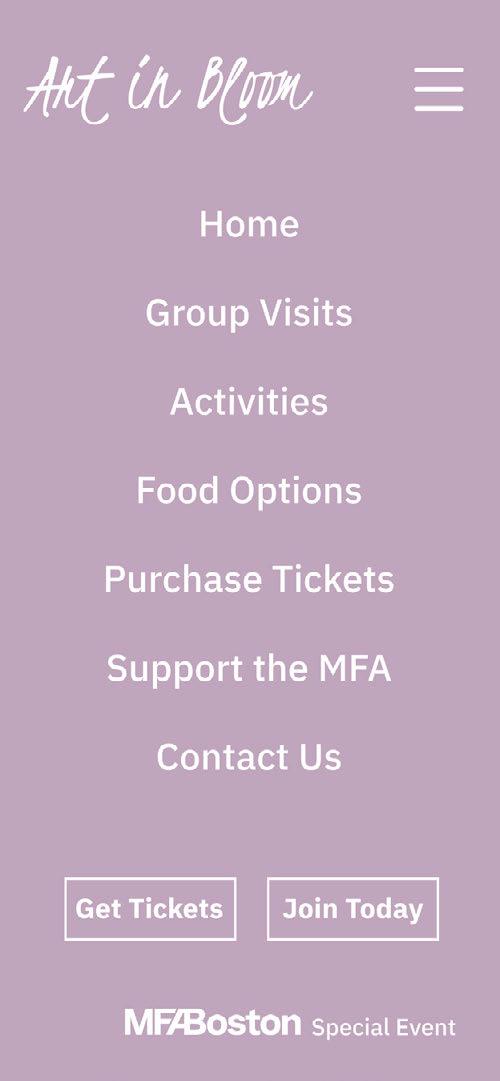
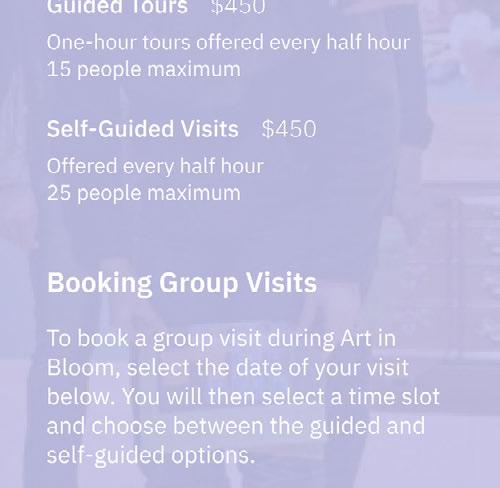

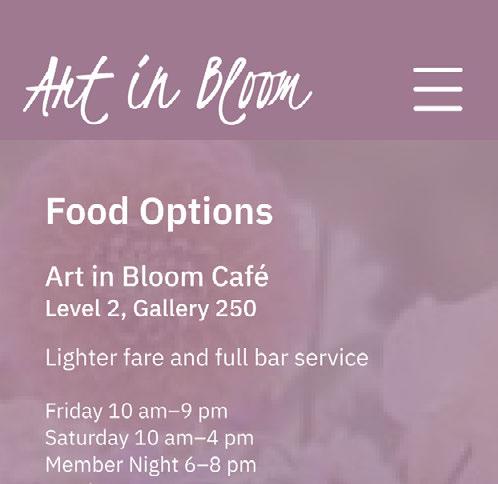
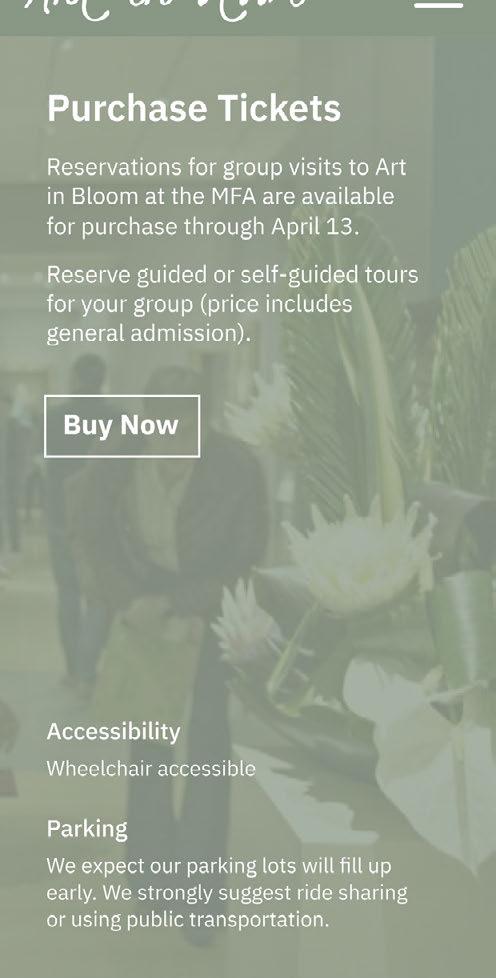
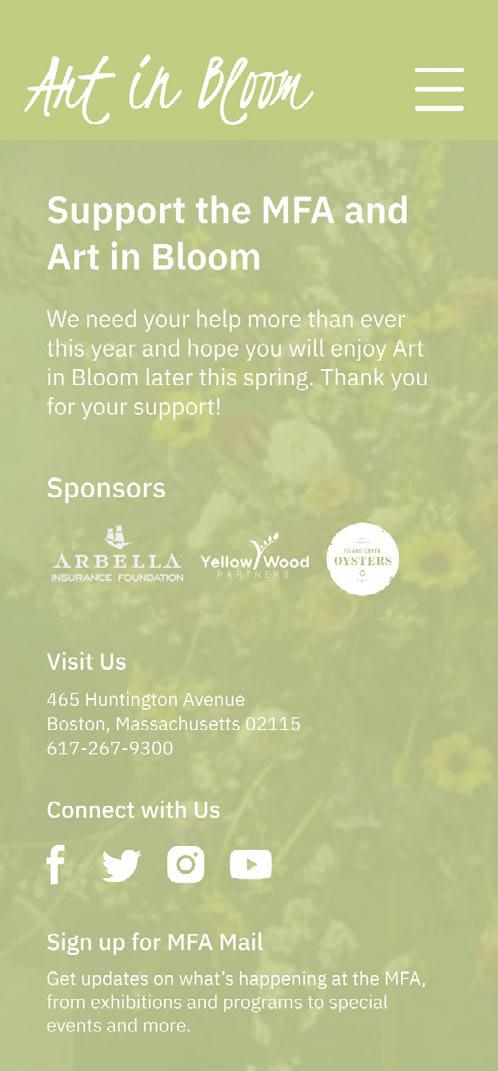
20
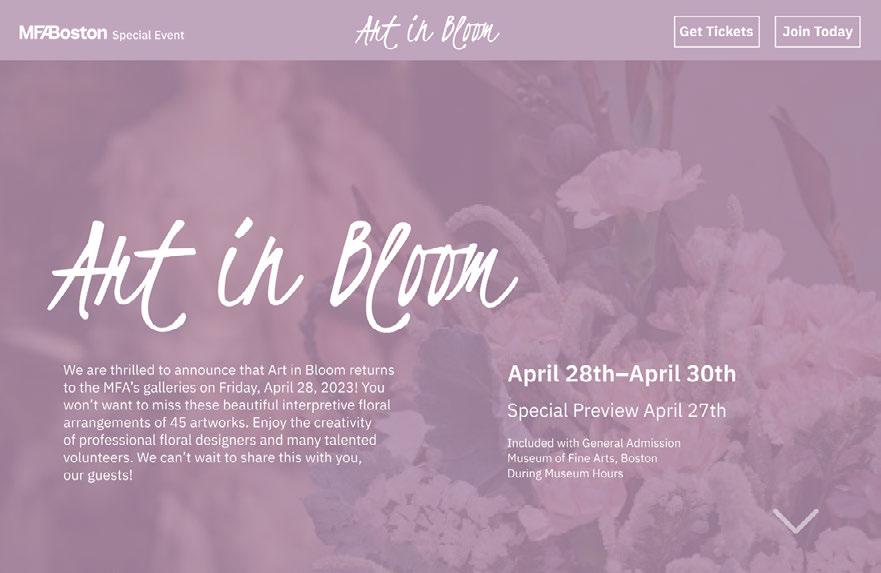
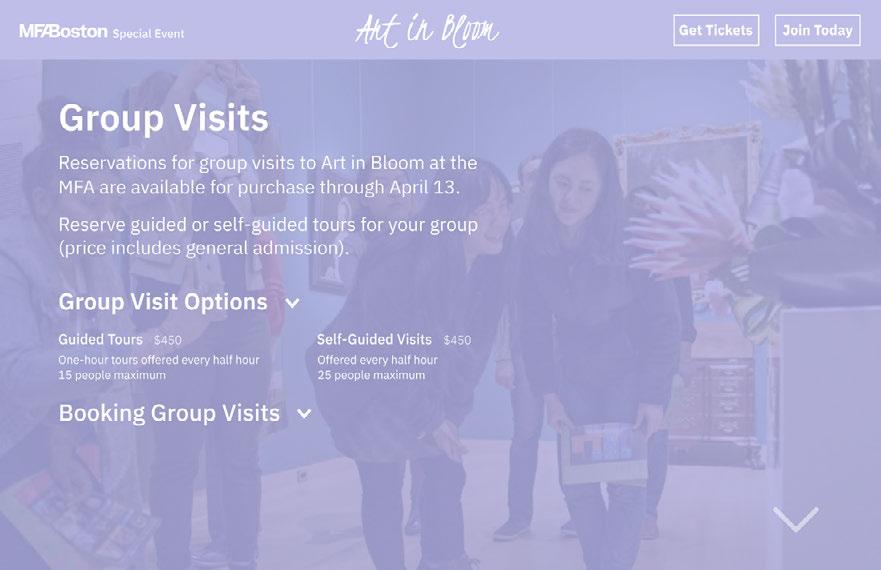
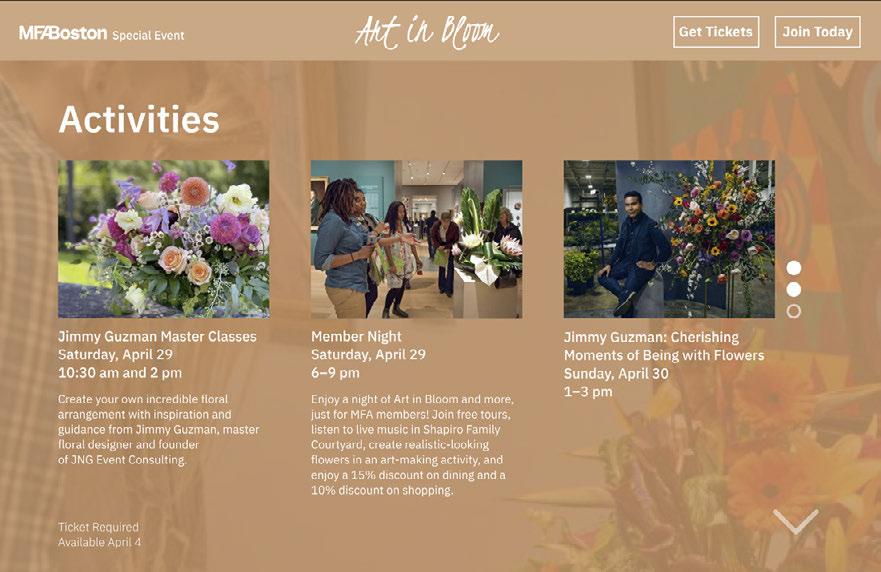
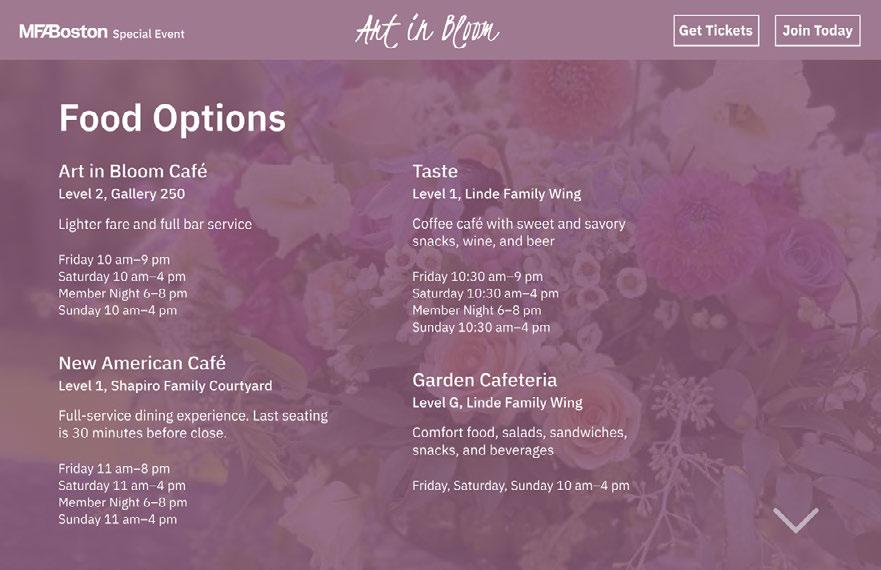
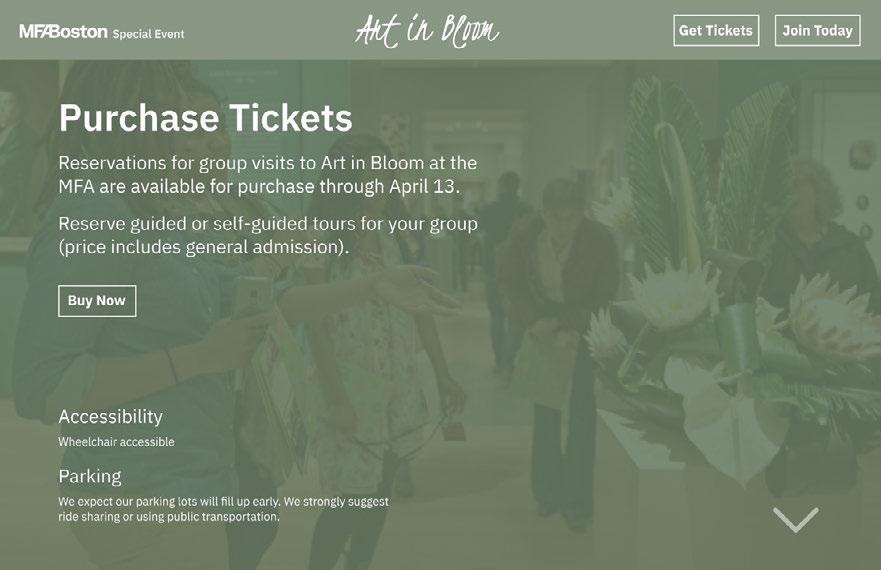
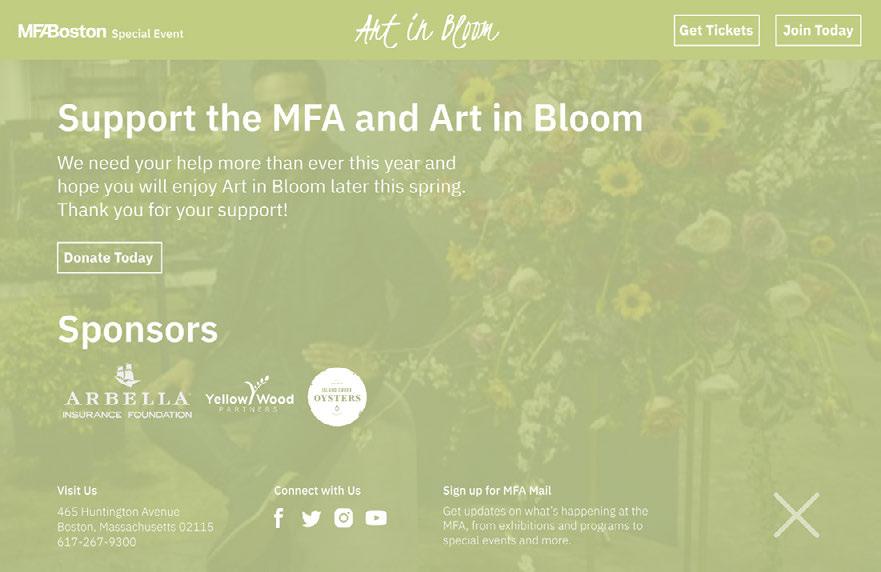
I maintained a similar system for both my mobile and desktop versions, mainly just choosing to included more icons on desktop that would allow one to click through the pages rather than scroll.
21
information design
information
design principles | prof. doug scott | spring 2024
Centered around four major projects, this course explored how to convey meaning and messaging through a combination of icons, text, and data. With an emphasis on prototyping and time management, each week I was expected to have printed progress on multiple ongoing projects. Most importantly, I learned how to convey information with as few words as possible. Each project explored different types of information, from maps and signage to instructions and researched data, all requiring the development of a strong visual system.
This large print is a visual representation of 32 pieces types of data surrounding the country of Colombia, organized into different graphics. After some research on the country, I had the daunting task of finding a way to bring all of the data together in a way that would be legible and informative. There are many rounded forms, and the colors are inspired by the red, blue, and yellow of the Colombian flag.
22
32 DEPARTMENTS OF COLOMBIA SIZE COMPARED TO 9 STATES PRECIPITATION (mm) AGRICULTURAL PRODUCTS (% of output) AVERAGE SURFACE AIR TEMPERATURE (°C) SUNSHINE HOURS PER YEAR LAND USE (% of total) ENERGY CONSUMPTION IN RELATION TO U.S. POPULATION DISTRIBUTION FERTILITY RATE (per woman) AGE STRUCTURE NUMBER OF AIRPORTS RAILWAYS (km) MAIN EXPORTS ($ bn fob) MAIN EXPORT DESTINATIONS (% total) MAIN IMPORTS ($ bn cif) MAIN IMPORT DESTINATIONS (% total) POPULATION IN RELATION TO NEARBY COUNTRIES (in millions) POPULATION PER SQUARE KILOMETER (in millions) 44 people SOCIETY (% of population) INTERNET USE DAILY USE OF MEDIA (% who conusme every day of the week) RELIGION (% of total) POPULATION CHANGE OVER THE LAST 100 YEARS (in millions) S O U T H A M E R I C A Olivia Champagne NEU 2024
Complied on a presentation summary to represent each sign in relation to the scale of the human body, this sign system for the art and design department included a map of sites used by students, a directory for Ryder Hall, a directional sign between Ryder and the Gardner Museum, and a room sign for our classroom. I wanted to use the university’s colors, and included a pairing of a serif and sans serif typeface to develop hierarchy. The color red highlights important information, and each sign has a light grey in the background and rounded corners for consistency.
23 11 Leon Street Ell Hall 35-37 Leon Street 43 Leon Street 465 Huntington Avenue 25 Evans Way 39-41 Leon Street Northeastern University College of Arts, Media and Design
Dean’s Office Center for Design CAMD Makerspace Art & Design Printing Creative Technology Lab Media Services Art & Design Printing Art and Design Office Ryder Hall Northeastern University College of Arts, Media and Design Typefaces used: Georgia Pro, Myriad Variable Concept
Isabella Stewart Gardner Museum
This project serves as a map of three routes from my Boston living space to different locations: my hometown, class in Ryder Hall, and a hotel in Venice, Italy. Each trip is shown in a different color, and the line type determines whether I was walking (dotted), driving (solid), or flying (dashed). Along each line, icons represent a minimum of fifteen kinds of information about the journey, such as the weather, landmarks I passed, and things I ate.

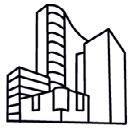
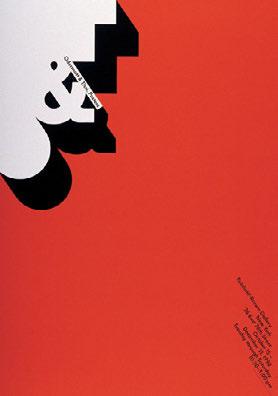
24 Pop Art was a design movement in the late 1950s and 1960s. Tissi finished her apprenticeship at Siegfried Odermatt's studio and after ten years of working together, they became partners, naming the studio O&T (Odermatt & Tissi). Graphic Designers Jock Kinneir and Margaret Calvert designed a system of motorway signage in 1963 that remains in use today across the United Kingdom. 1958
Olivia Champagne NEU 2024 Some icons from Flaticon Typeface used: Acumin Pro
Ryder Hall Boston, MA Hotel Tre Archi Venice 7:46am 1/8/24 23°F Call with Mom Dunkin’ ISEC Ruggles 3:14pm 1/23/24 28°F Earth, Wind & Fire CubeSmart Carter Playground Massachusetts Avenue New York Pizza Christian Science Center Milford Dance Center Pooch Hotel Social Media Sheraton Framingham Charles River Our Lady Help of Christians Fenway Park Warrior Ice Arena Plains Automotive Berklee College BU Dorms Charlie the Tuner Price Chopper Dublin Airport Glazed Donuts from Dunkin’ Entering Logan Airport Terminal E Cup of Water Chicken Dinner The Alps Freshening Up Blueberry Mu in Invisible Cities Venice Marco Polo Airport Texting Home The Rookie Invisible Cities 17 Hours From Logan to Venice Marco Polo 0.5 hours 1.75 hours hour hour 2 hours 5.5 hours 1.75 hours 0.5 hours 0.5 hours 1.5 hours hour
Journeys from Lightview
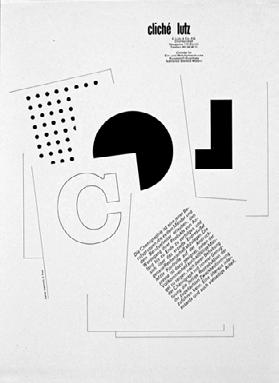
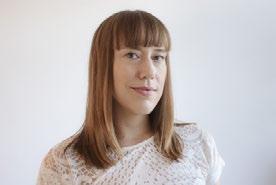


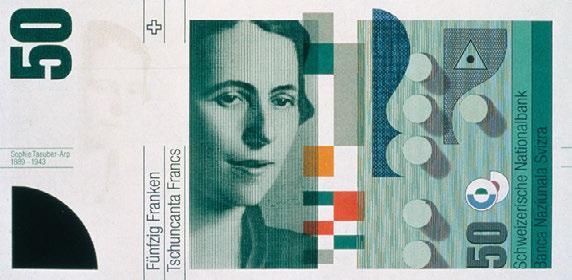

Rosmarie Tissi was granted the Swiss Grand Award for Design.
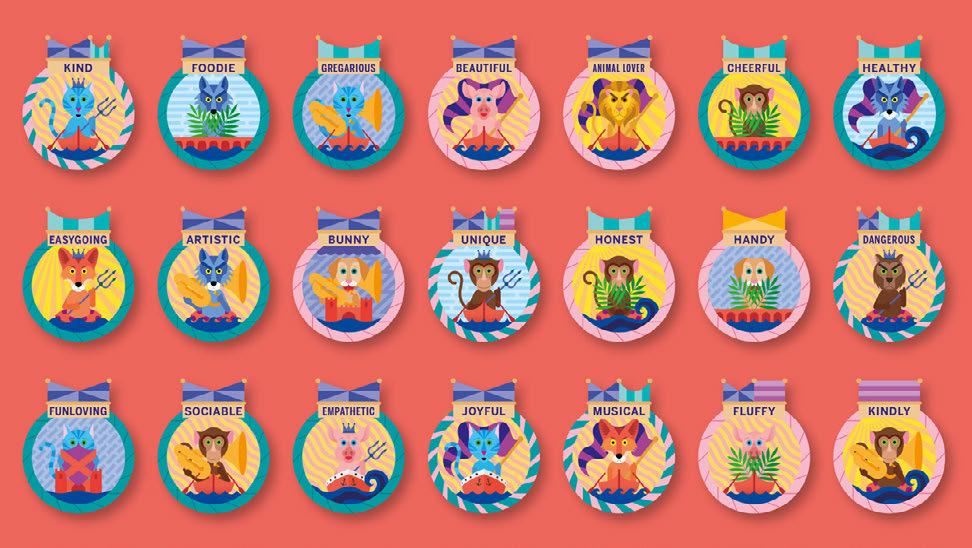
Siegfried Odermatt, whom Tissi was an apprentice for and later partners with at Odermatt & Tissi, passed away in 2017.
Stefanie Posavec completed a Practitioner in Residence at Royal Museums Greenwich. As part of their launch of a new wing of the National Maritime Museum, she gathered data from visitors to the museum and used it to create what was called “The visitor fleet,” a wall of pictures of visitor badges that have ship names and personalities listed.
This fold-out timeline brings together details from the lives and work of designers Rosmarie Tissi and Stefanie Posavec, alongside key historical dates and developments in the design world. Important dates are large and bold, while the symbol corresponds to the designer’s line, in a color commonly found in their work. Posavec’s work had a more organic feel, represented with circles and a curving line, while Tissi was more rigid and geometric, with squares and a bolded line.
25
2018 2019
Stefanie Posavec was born in the United States.
Tissi designed an advertisement for the printer E. Lutz & Company. 1953 1974 1981 This is the back of a presentation folder Tissi designed for the printing company, A. Schöb. In 1983 ARPANET makes the transition to the protocol of the World Wide Web, marking the birth of the internet and acts as a foundation for the internet known today. 1982 Tissi received 2nd prize at a competition for a New Swiss Banknotes Design.
Rosmarie Tissi becomes a member of the Alliance Graphique Internationale (AGI). The 1970s marked the start of postmodern design.
at the 11th International Poster
The first Macintosh was invented by Steve Jobs in 1984, the first personal computer to be successful commercially and featured a mouse and graphical user interface. The first version of Adobe Photoshop was released in 1990. 1986 1989
Rosmarie Tissi received first
prize
Biennale in Warsaw.
graphic design
graphic design 1 | prof. margarita barrios ponce | spring 2023
My graphic design course last year was centered around three major projects: a poster series for three U.S. National Parks, a book featuring forty word-a-day postcards, and a object translation that would be turned into an advertisement for that object. I consider iteration to have been the most important theme of the class as I worked through designs from early sketches to final design files across the entirety of the semester. I found it to be a bit of a challenge to start, adapting to using Adobe software in new ways, however I learned a lot about working in series and starting to develop my own style. I really enjoyed the variety of projects and found that they helped me train my eye to pick up on finer details that carried over into other courses.
These three posters make up my final poster series, all using an image-traced photo in the background, a consistent type hierarchy and muted color palette, and illustrated symbols that represent three of the activities featured within each park.

26
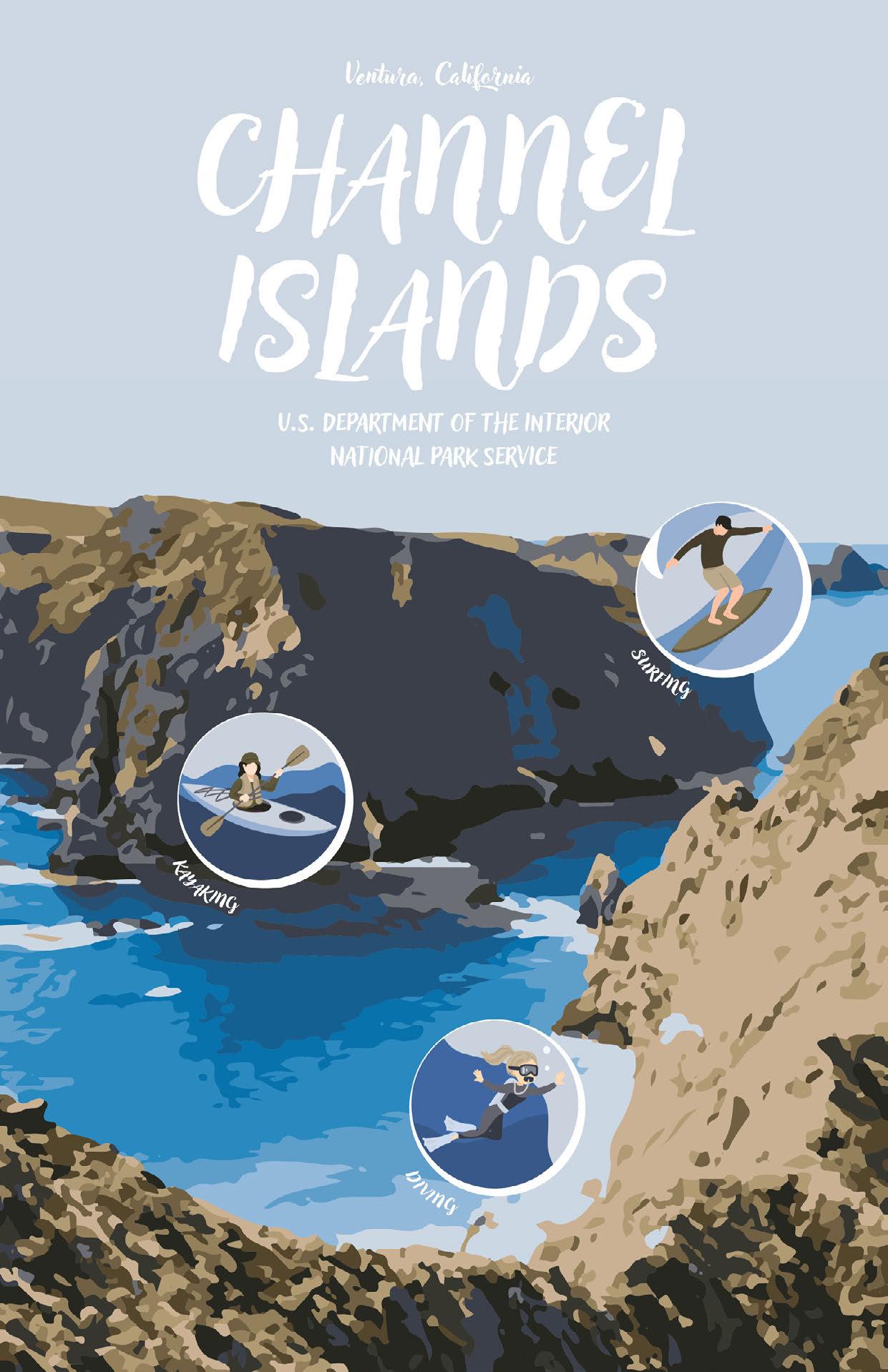

This semester long project followed Merriam Webster’s word-a-day definitions starting at the beginning of the year to develop a book of postcards that graphically represented the meanings of each word. For consistency, I developed a color palette and system for each of my postcards that involved a central circle on the front that would contain my simplified illustrations.







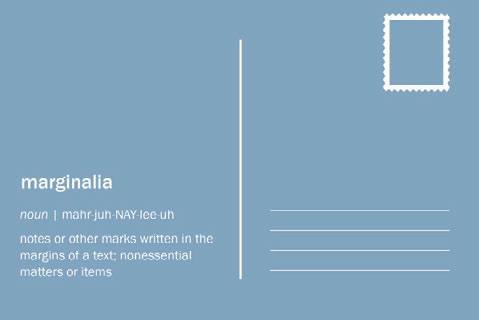
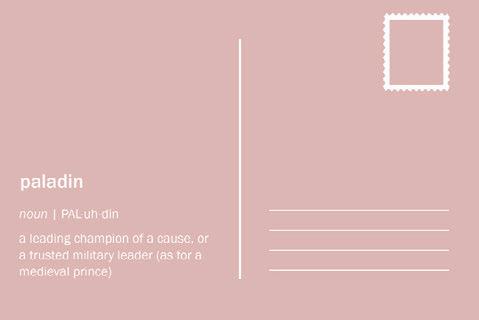






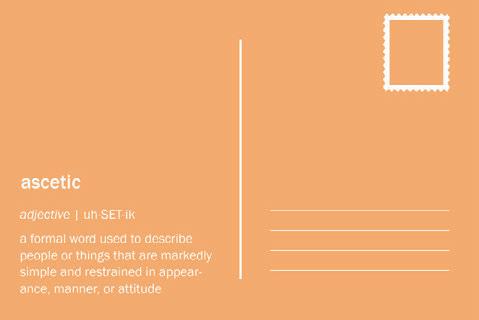
28
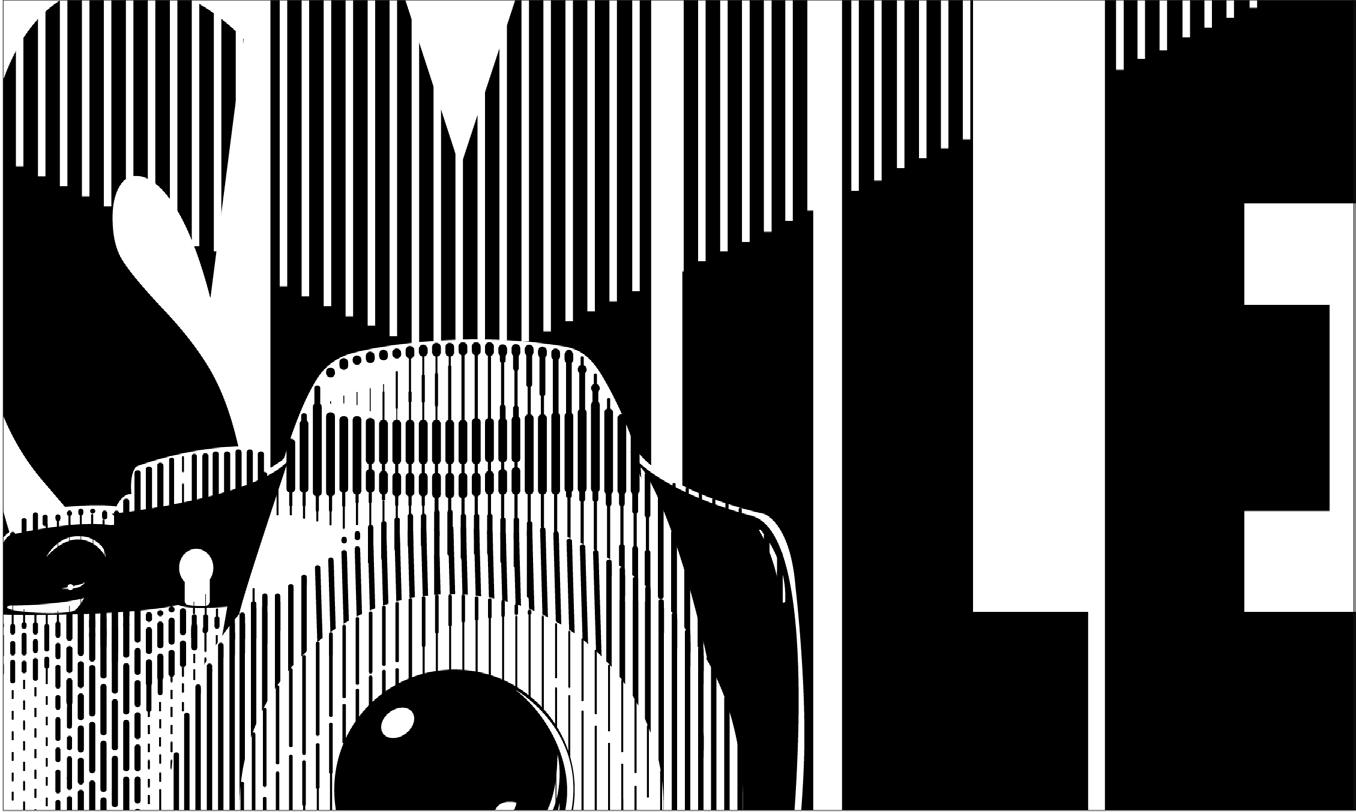
I digitally recreated my camera for this advertisement using lines of a variety of weights to convey light and shadows. I wanted the audience to view the camera as if they are having their picture taken, corresponding with the word “SMILE” in the background, a phrase I hear every time someone takes my picture. I played around a lot with where the camera would fall in the composition, but ultimately decided to place it in front of the letter “M” and have the camera’s flash stretch across the rest of the text using another line pattern.
In this older project, I chose a poster by Mitsuo Katsui and developed a series of posters that draw inspiration from his design. I also visualized how the posters might be displayed on a digital screen, with movement across the three.
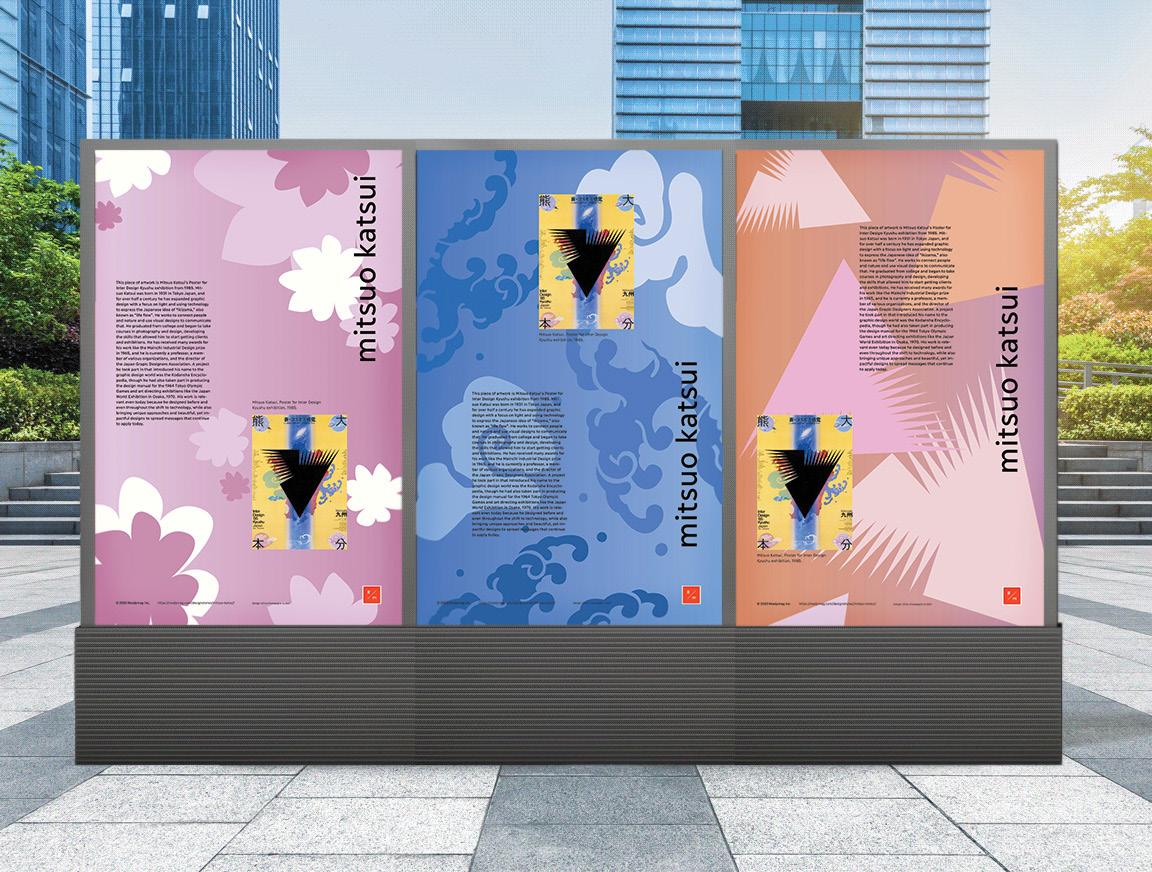
29
artistry magazine
This past year, I joined the design team for Artistry Magazine, a student run arts & culture publication at Northeastern. After articles were submitted by students, I had the opportunity to take ownership of a few spreads for the semester publication to develop the layout and visual components of the spread. While the magazine does uphold certain typesetting requirements, I determined which photographs were used, the color palette, and the typeface(s) used for the title of each article. I also had the opportunity to design the cover of the magazine for the spring semester, as well as adapt it for use as a poster.
AUTHENTIC EXPRESSION
AS A DEEP EXHALATION OF RELIEF
Why does society accept and proliferate ways of living that are toxic to our well-being? MassArt Art Museum explores this question in its current exhibition, “The Myth of Normal: A Celebration of Authentic Expression.” Running from October 5, 2023, to May 19, 2024, this exhibition focuses on work from MassArt’s alumni. It is divided into three sections: Body as Architecture, Untold or Unheard Stories, and Authentic Expression in Action. These interrelated groupings guide the visitor through a deep examination of the toxic norms held by modern society.
It leaves the viewer with a sense of liberation and inspiration, subverting expectations at every turn.
The exhibition draws inspiration from the book, “The Myth of Normal: Trauma, Illness, and Healing in a Toxic Culture” by Gabor and Daniel Maté. The Matés uncover the wrongdoings of Western medicine, exploring how chronic illness, general ill health, and mental illness are on the rise despite “advancements” in medicine. This book sheds light on how the stressors of today’s culture burden our immune systems. The Matés offer authentic expression as a step towards total health. “The Myth of Normal” exhibition is a space for such expression.
The first room in “The Myth of Normal,” Body as Architecture, accentuates feelings of oppression and constraint. The artwork houses imagery of physical architecture as an extension of the human body. It begins outside the museum with two portraits of MassArt freshmen painted high above the front entrance. Inside the Body as Architecture room, this motif continues. Chandra Mendez-Ortiz’s Parks Entrance collages personal pieces, as well as others she found, into a layered narrative of one African American family’s experience living in the South under Jim Crow.
The second space titled Untold or Unheard Stories, displays works that illuminate the histories covered up by an oppressive society. Jack Pierson’s Boston #1 documents the underground gay scene in a period of conservatism and homophobia. These black and white photographs convey deep emotion and eloquent sexuality, detailing the once-hidden spaces of selfexpression. In the middle of this room is a sculpture impossible to miss: Richard Streitmatter-Tran’s Gluskabe Comes Home a large woodchuck figure from indigenous cosmology. It symbolizes the artist’s ancestry and the stories passed down through generations.
As you ascend the stairs into the Authentic Expression in Action section, a series of hanging wigs come into view. The delicately placed hairpieces were collected from drag performers as a part of Kathleen White’s Spirits of Manhattan This artwork addresses the AIDs epidemic and the many lives it took. This Authentic Expression in Action room fluently concludes the “Myth of Normal” series. The self-expression in this room, though at times tragic in nature, is a stepping stone towards liberation. It is a deep exhalation from the toxicity of societal standards and a pragmatic call to action.
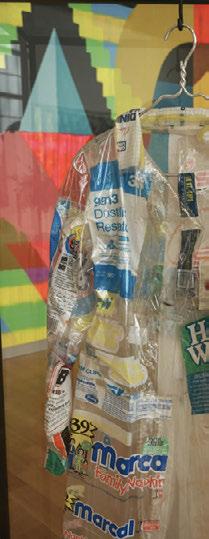

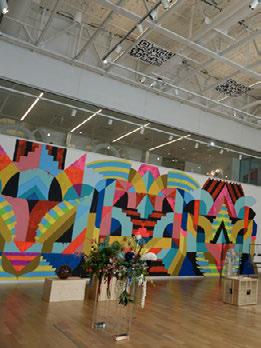
Written & Photographed by Abigail Farmer
Designed by Olivia Champagne
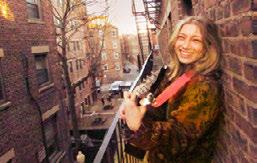

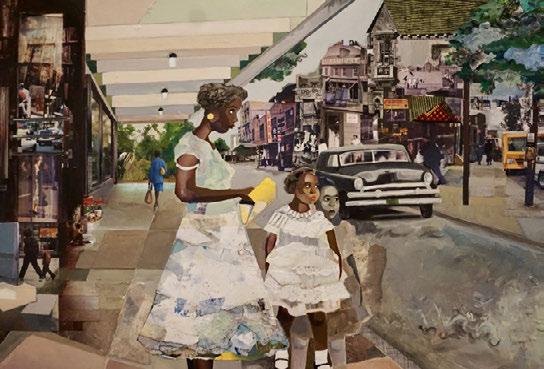
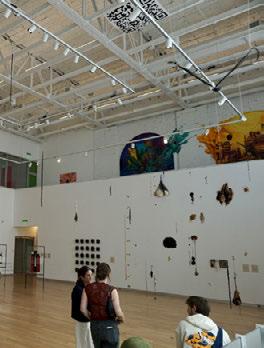
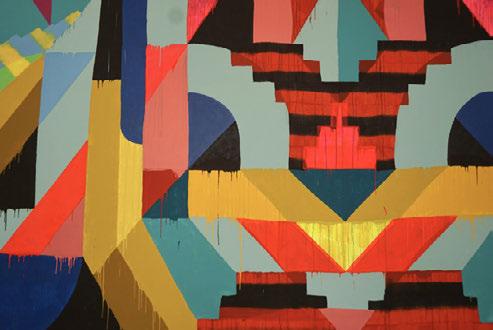
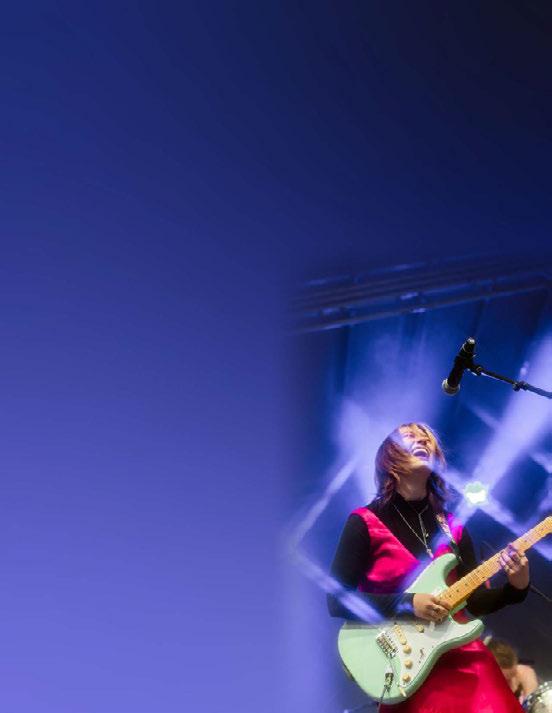

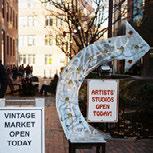




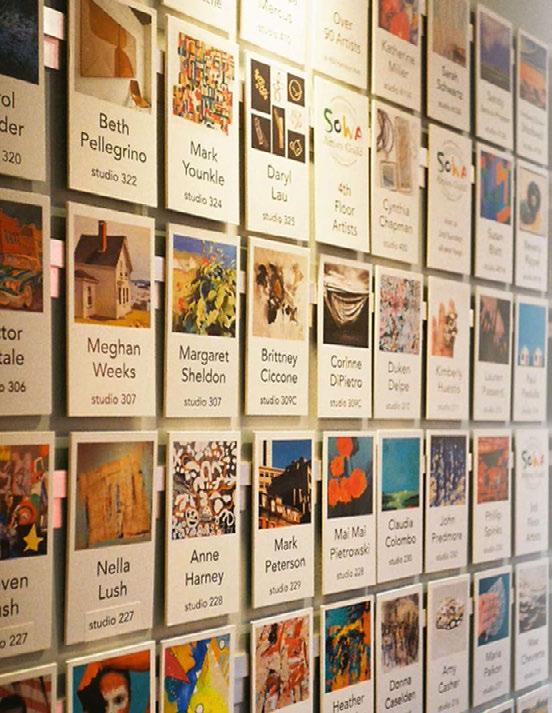



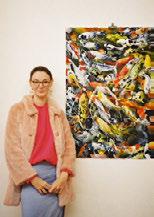


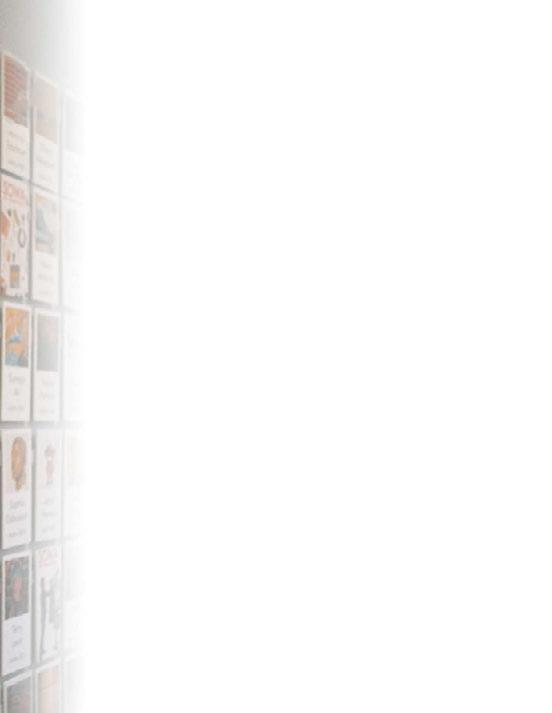


30
You know, it’s funny because, with a lot of the songs, I’ll think to myself, “Oh, was a baby when wrote them, it’s just not relatable,” but they are still relatable, and they’re kind of snapshots of life. They capture moments like falling in love for the first time or getting mad at an ex—the little moments of growing up. started writing songs at 13 when had no idea what the hell was going on in the world, but it helped me find my voice and connect with others. It’s the power of music: you get what I’m saying, and I get what you’re saying. What elements do you personally think make a body of art, like an album, timeless? think there’s a lot of music that is made now that doesn’t have that timeless quality, and that’s really because you can tell a certain part [of a song] was made for a TikTok. The hook is the perfect soundbite for a TikTok, the rest of it is not. And that’s not to dismiss any artists who may have blown up on that platform or to dismiss the huge benefits of that. Streaming and social media have done a lot of things for the accessibility of music. However, think TikTok in particular, with that idea of a 15-second clip that has to be catchy, has made it hard to write songs and want to show them on the internet for people to listen. It can be difficult to avoid tailoring your music to fit a specific trend or trying to include a part that can become a trending soundbite. think the best artists are the artists whose album sounds different every year. You know, you think about Radiohead–each album is drastically different because they’re just doing whatever was true to themselves at the time. think that authenticity makes for timeless, genuine music. How has your artistic expression/style evolved? What pushes you to try new things, expand your horizons? I started playing [music] with a lot of other people, which has had a huge influence on the way that write songs and the way that view arranging in general. started playing guitar with Eph See, who did the student showcase last year! That experience changed everything for me; it was the first time I’d ever played music for someone else, like in someone else’s band as someone’s guitar player. So having that moment of appreciating someone else’s music and understanding how they hear the music versus how they recorded it versus where it is now, and the way music changes and grows—that was so inspiring. Even seeing the songs that they’ve written in the time since we started playing together and the way that their style has changed has been a huge inspiration for me. I was also the president of the Songwriting Club for two years which was so much fun. That was also a massive source of inspiration to try new things because you’re exposed to all sorts of crazy stuff! And the best thing about the music scene at Northeastern is that it’s really tight-knit. Everybody knows each other, and you’re able to grow so much from hearing what the people are doing. What are some short or long-term goals you wish to achieve as a musician? I’d say short-term, more music out. love playing shows so much, and that’s also going to be a big goal of mine as soon as get my song out on Spotify. just need a single on there, and then it makes sense to go play shows before plug myself. So, I’ll definitely be playing shows or releasing more music within the next year. would love to keep that going. I’m not anticipating being a touring musician as my job. I’m probably going to go into music therapy, which think is very cool. But, that’s so far away. Everything before that and in between and during, will be playing music in my life. And think a part of timelessness is just being true to the music that you’re making. 10 Evergreen Fall 2023 C orinna Parrish is a fourth-year combined psychology and music major at Northeastern University. She started her creative endeavors as a student in New York and has since continued to write her own songs, play guitar for other bands, and grow as a musician. As the former president of the Songwriting Club on campus, she draws inspiration from collaborating and surrounding herself with others who can share her love for music. This interview, originally conducted in the fall semester of 2022, has been edited and condensed for clarity, with editor notes added in [brackets] to provide context. How did you develop your skills as an artist? Where did you start? grew up in a very musical household. I’ve always been encouraged artistically, and think started writing songs probably in middle school after started playing [music] by myself and writing songs from start to finish. As an eighth grader, going through a lot, learning how to become a human being and all, it felt like a huge outlet for me. Where do you draw inspiration from? Tell me about your biggest creative influences. This is going to sound cheesy but, honestly, a good break-up is primo inspiration. mean, remember was going through a breakup, and was talking to my ex’s mom, who told me, “You’re going to write so many great songs!” In the moment, it felt so overwhelming, but think it’s usually a very therapeutic outlet for me. A lot of the time, just have so many emotions don’t know how to grapple with, I’ll write them into a song. I’m a very emotional person in general, so feel like songwriting has been a great way to figure out what I’m feeling. Kind of like journaling, which I’ve turned to for inspiration. find that the things that happen in life, you don’t realize they’re good material until you write them into a song. You’re like, “That was such a simple thing!” But their simplicity can make them the most relatable— able to reach a lot of people, speak to them, make them feel understood. Our theme for this semester’s issue is “Evergreen,” as in timelessness, enduring influence, and ceaseless importance. With that in mind, would you consider your artwork evergreen? If so, what qualities make your work timeless? think the way see the answer is two-fold: the inspiration behind the music and then the music itself. listen to a lot of music; I think all musicians should listen to a lot of music. It’s good to know what other people are doing, whether that be country, classical, jazz, or whatever it is, kind of just seeing what’s out there. And think that’s really what pushed a lot of my songwriting. It was listening to a lot of new stuff, a lot of folk music, country, but also listening to classic seventies rock, indie pop, and all that sort of stuff. So kind of having that amalgamation of old and new in my inspiration, think, has had a huge influence on the way view and approach songwriting. Photographs from Corinna Parish Designed by Olivia Champagne Student Showcase CORINNA PARRISH 9 SoWa Boston B oston-based artist Patricia Busso’s selftaught process is a journey of exploration and joy. Through oil paints, coals, or torch-burned encaustic materials, “the beauty of randomness” echoes through into her complex mixed media works. When she isn’t expressing bliss through painting, she’s teaching high school math. Busso is one of more than 100 local artists that produce work in SoWa’s sprawling studio center which comprises of three floors on 450 Harrison and a few studios on 46 Waltham. Nestled between refurbished industrial warehouses in Boston’s South End lives SoWa (South of Washington) Art + Design District, a new hub for artists, galleries, designers, and other creators. “Around 2003, 2004 – this part of the city was still very transitional. It’s not a part of the city that spent any real time in because there was not much here,” said Steven Zevitas, president and owner of Steven Zevitas Gallery and the Open Studios Press. “A gentleman who owns the property we’re in earmarked 450 Harrison—he thought of it as an arts building—a combination of artists, studios, art galleries, and other businesses that are directly and tangentially related to the arts, interior design, that sort of thing.” The industrial-chic area boasts trendy eateries, a beer garden, and a vintage market, offering one the ability to both look at art while enjoying various other goods from local vendors. Upon entrance to the main studio building, one can find contact cards for all the artists found on the three floors above, with their names and room numbers lining the wall as paint sample cards for easy access. Each floor houses dozens of studios, showcasing a wide variety of artists in their element. Written and Photographed by Batool Abbasi Designed by Olivia Champagne From monthly celebrations like First Fridays to Art Walk events, during which artists, galleries, shops and showrooms are open and free to the public, SoWa fosters a connection between artists and the Boston community. 43 Some rooms are calming, others an explosion of color. Each studio features the artist and their personal style as much as their actual art. A visitor is able to view pieces in the comfort of the artists’ studios. In this space, one can find an artist painting away on an easel or engaging in fruitful conversation with curious observers drawn to their craft. It is collaborative and welcoming, offering a space for dialogue that makes the art a point of bonding. As a visitor of this space, one can be pulled in by the intriguing backstory of each artist—what makes their work unique to them? What is the purpose of their craft? Liza Foley, an abstract painter and pet daycare owner, draws inspiration from nature—from scenes of travel with her husband and dog, whether it be under the glowing sun or in the depths of the Berkshire mountains. Her purpose is to evoke emotion or balance one’s mental state. For Cedric Harper, who worked for 30 years in healthcare as an advocate for individuals with disabilities, art is like breathing. To Harper, it’s art when it feels essential and nonperishable. Harper’s sculptures of splattered and spinned color are done upon discarded and then reclaimed wood to capture this feeling and reimagine their potential. Emily Song’s focus is adventure, with the goal of making her audience feel what she feels when she paints: a love for life and all its wonder. Her vibrant watercolor paintings of landscapes and flowers capture the beauty of nature and its complexity. Monrud Becker, mixed media artist and oil painter, draws inspiration from Dutch still lifes, in conjunction with aspects of modernity. His work is an exploration of color and composition integrated with hidden elements that add extra layers to pieces of work that may seem simpler upon first viewing. His detailed oil paintings seem to freeze time in a single moment, while his sculpture-inspired paintings combine paints and sand to create structure and convey the passage of time. He remarks that his work is not meant to create emotion but could still pay homage to a past feeling or memory. Through elaborate mixed medium structures and paintings, Duken Delpe strives to initiate a contemporary conversation on topics such as technology and racism. Delpe’s work investigates current issues in the world through the use of materials with the creation of his pieces from everyday objects such as phones and computer motherboards. Steven Zevitas said, reflecting on the art business and working with artists. Free of admission, one can visit SoWa’s art and design district on weekdays from 9-5 a.m. and weekends from 12-4 p.m. to experience this nurtured, unique space that is conversational and personal. This article was written in Spring 2023. Keep a lookout for SoWa’s Fall and Winter events like their Winter Festival, which features artists, makers, designers, food, drinks, and more. Learn more at https://www.sowaboston.com/. “It tends to be very rewarding day to day, just in terms of the people you’re interacting with, the conversations you have, and all that good stuff. That’s really what makes life go around,” 44 Evergreen Fall 2023 Tryzub Trio, Maya Hayuk Recycle Coat , Mimi Smith And and If Bahar Yürükoğlu 18
17
Student Showcase
SUSHMIT





FALL 2023
I experimented a lot with with opacity, gradients, and blending to incorporate photos with the article text, while trying to capture the feel of the article visually.
SPRING 2024
The theme this semester was “saturate,” and I chose to work with a lot of color, texture, and repetition for the magazine cover. In my spread design for an exhibit, The Myth of Normal, I wanted to carry on the unique quality of the different pieces in the photos.
31
2 Evergreen Fall 2022 This interview has been edited and condensed for clarity, with editor notes added in [brackets] to provide context. Can you describe your journey as a photographer and what initially drew you to this medium? My dad has been a huge influence. He’s been taking photos since before was born. had previously taken one or two workshops on how to use a camera, but if I’m being honest, didn’t pay attention. It was really the night of an alumni event attended where was assigned as a photographer. As a whole, am a huge proponent of self-learning, and after that night, decided to teach myself to take photos. What draws me to the medium is that photography is essentially capturing a moment in time, and you can get creative with that. That’s a magical thing don’t see many people appreciate as much as they should. What photographers, artists, or other influences have had a significant impact on your creative vision? A lot of them are graphic designers follow online. To name a couple, @oversettext and @prettycoolstrangers on Instagram. There’s one specific photographer whose work is great, Conor Cunningham, and he shoots for a ton of different magazines. When want to practice or go out of my comfort zone, look at these artists and try to implement something new, while also keeping my own stylistic elements that people can enjoy. How do you typically prepare for a photoshoot, from conceptualization to execution? will be very honest, rarely prepare. Most of the time, it’s very on the spot and essentially go “Hey, this would look really good as a photo.” don’t really do formal photoshoots, it’s mostly outings with friends that happen to turn into cool photos, which in my opinion is the best way to approach photography. Looking at your Instagram, can see your creative expression extends beyond photography —are there any other mediums you’ve explored or plan on exploring? would say most of my creative expression lies in graphic design. I do a lot of digital work, that’s mostly where my work lies. Graphic design and photography are the two main mediums use. I’ve also explored film as well, however, It’s much harder to film something because we are in college and there’s just no time. Can you tell us about any ongoing or upcoming projects that you’re particularly excited about? do have a current project which isn’t exactly graphic design but has many graphic elements. It’s very mixed media. Lots of cutting and scanning of paper involved to make something cool hopefully. What do you want people to take away from your art? A lot of people like to design a deep meaning to art, and while that’s a beautiful thing about humans, believe art can exist just for the sake of being art. Oftentimes when I’m showing someone something made, one of the first questions they ask is “What is this supposed to represent?” Our theme for this semester’s magazine is “Evergreen,” as in timelessness, enduring influence, and ceaseless importance. With that in mind, would you consider your artwork evergreen? If so, what about your work is timeless or everlasting? While don’t believe my work at this moment is “everlasting,” believe a lot of the concepts try to embrace are. A lot of the work do is essentially trying to make art out of the mundane. think we should celebrate the mundane more, and that idea in itself would describe as a timeless concept. It’s something that will be represented in all artworks, not just mine. What draws me to the medium is that photography is essentially capturing a moment in time, and you can get creative with that. Sometimes just want to say it means nothing, just made it to have fun, which believe is the main proponent of it. first-year student with 18 Evergreen Fall 2023 S A T U R A T E S A T U R A T E S A T U R A T E A R T I S T R Y M A G A Z I N E S P R I N G 2 0 2 4 SATURATE SATURATE SATURATE SATURATE SATURATE SATURATE SATURATE SATURATE
boston public library rest stop
site, space, and program | prof. ang li | fall 2022
The objective of this project was to design a seasonal pavilion in the center of Boston’s Chinatown that would house a public restroom and an additional program providing public space fitting of the needs of the community. The restrooms had to be fully enclosed, but the rest of the space could be covered by some form of overhead shelter that was still left open to the elements.
Inspired by a public installation next to the site that doubled as ordinary seating and a performance space, I decided that my additional program would be imbedded seating similar to an ampitheater that faces a space carved into the wall of the structure that can act as a backdrop or stage. I wanted the space to provide more seating for people passing by just as much as I also wanted it to function for gatherings. I made use of irregular pentagons for the seating, main structure, and the pergola-like structure made up of wood and a trellis that partially covers the two. A key element of my design was accessibility, with a variety of ways to approach and enter the restrooms and seating area, but also the angles of the different elements and how they created different spaces.








A plan diagram analyzing circulation and spatial relationships within the site.

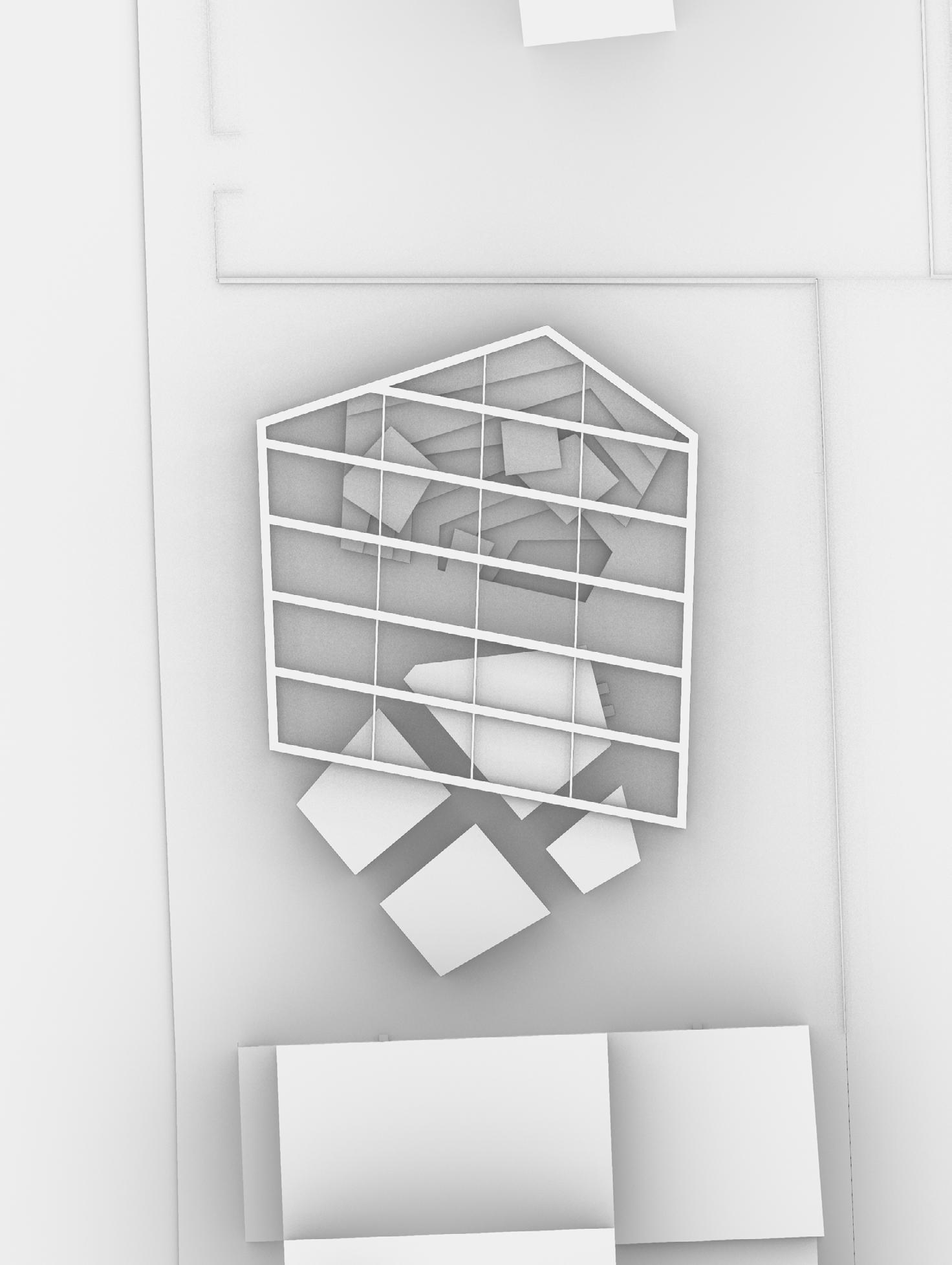
32 Wall angle creates a welcoming entrance for those approaching from the right of the site Alternative entry for those approaching from the other direction and during events Frame side parallel to Hudson St. Additional entrance to the site from back Intended exit from the rest stop, sending people back to the seating area past fountains Additional standing room available Main path to the rest stop Hudson St. Stage Alternative exit for when events occur Three angled walls that create a funnel of sorts to welcome and direct people into the rest stop The ampitheater-like style and shapes of the seating here allows for a variety of uses open, central area
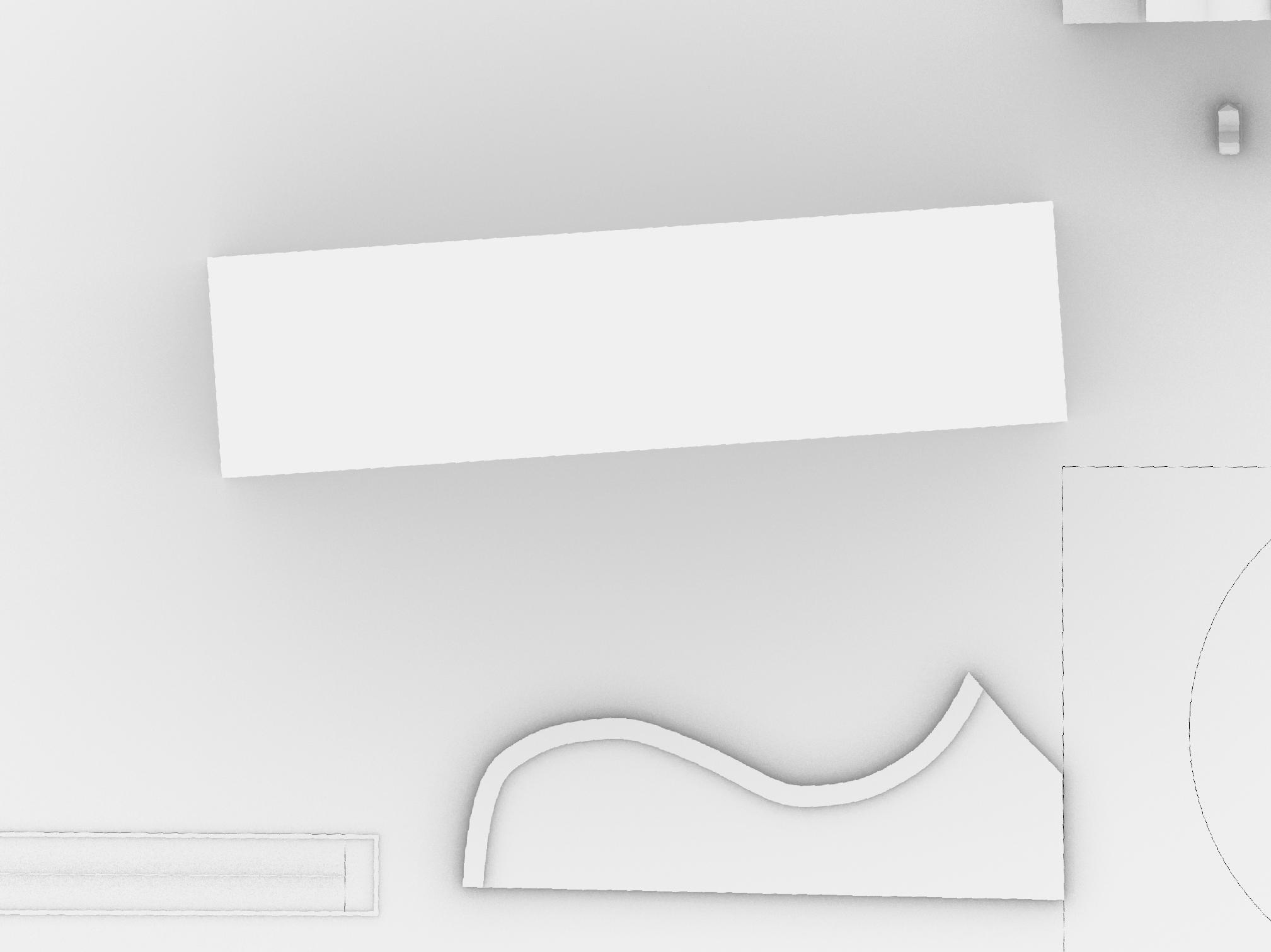



This plan drawing includes measurements and circulation paths around an existing public public pavillion.
A section drawing depicting that space in use for a public gathering, which highlights its variety of seating heights.
33 Olivia Champagne Site, Space, & Program Patterns of Use Diagram Community Pavillion’ 16’5” 3’2” 1’0” 10’10” 3’4” 3’4” 1’0” 3’0” 3’10”

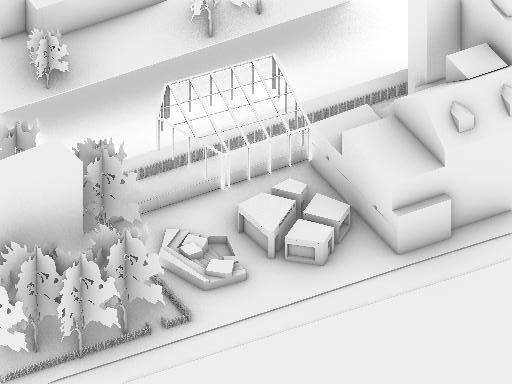
34
This exploded axonometric drawing highlighs the space contained within the frame, and the stage in use for a public event.

35

36


This section drawing highlights overhangs and seating that are carved out of the thickened exterior walls, along with the various level changes that are key to the public seating.


37
exploring and mapping playability
advanced architectural communication | prof. judith rodriguez | spring 2023
My section of this course, Playability in the City, involved the study of characteristics that impact or promote play in public places and how those spaces can be improved. I was assigned Downtown Boston and Bay Village to study for my first project, which involved visiting each of the parks in the neighborhood and documenting it through both photographs and lists of key features such as the number of trees, benches, and street lights. After being introduced to mapmaking using QGIS and layers made available by the city, I created a series of maps at the neighborhood and park levels. In particular, I chose to focus on transporation in one map since I consider park accessibility to be a determining factor in assessing playability. I also found that different types of ground covering and spaces to occupy have the ability to encourage more play, which I explored through diagrams.

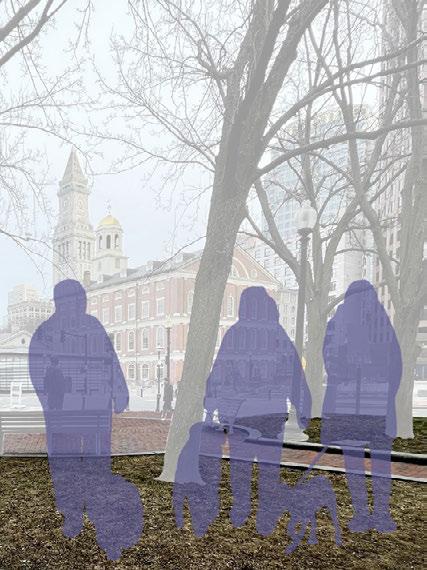


This map focuses on transportation routes through Downtown Boston and stops for blue bikes, buses, and trains, as well as all of the public spaces considered to be landmarks. Many parks in the neighborhood were also designated as Boston landmarks.
These are two sets of diagrams I created to highlight how softer ground coverings were better able to facilitate play, and the many ways public spaces could be utilized for play, intentional or not.
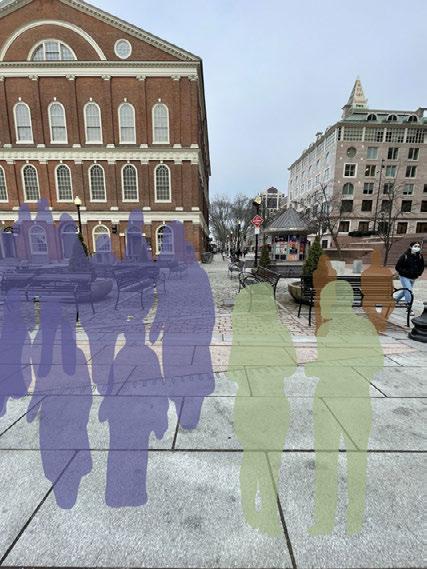
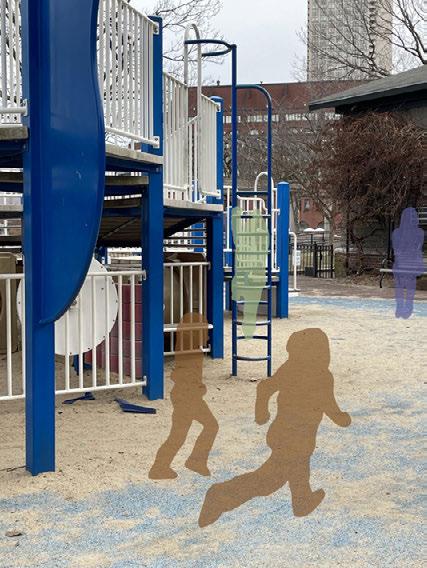
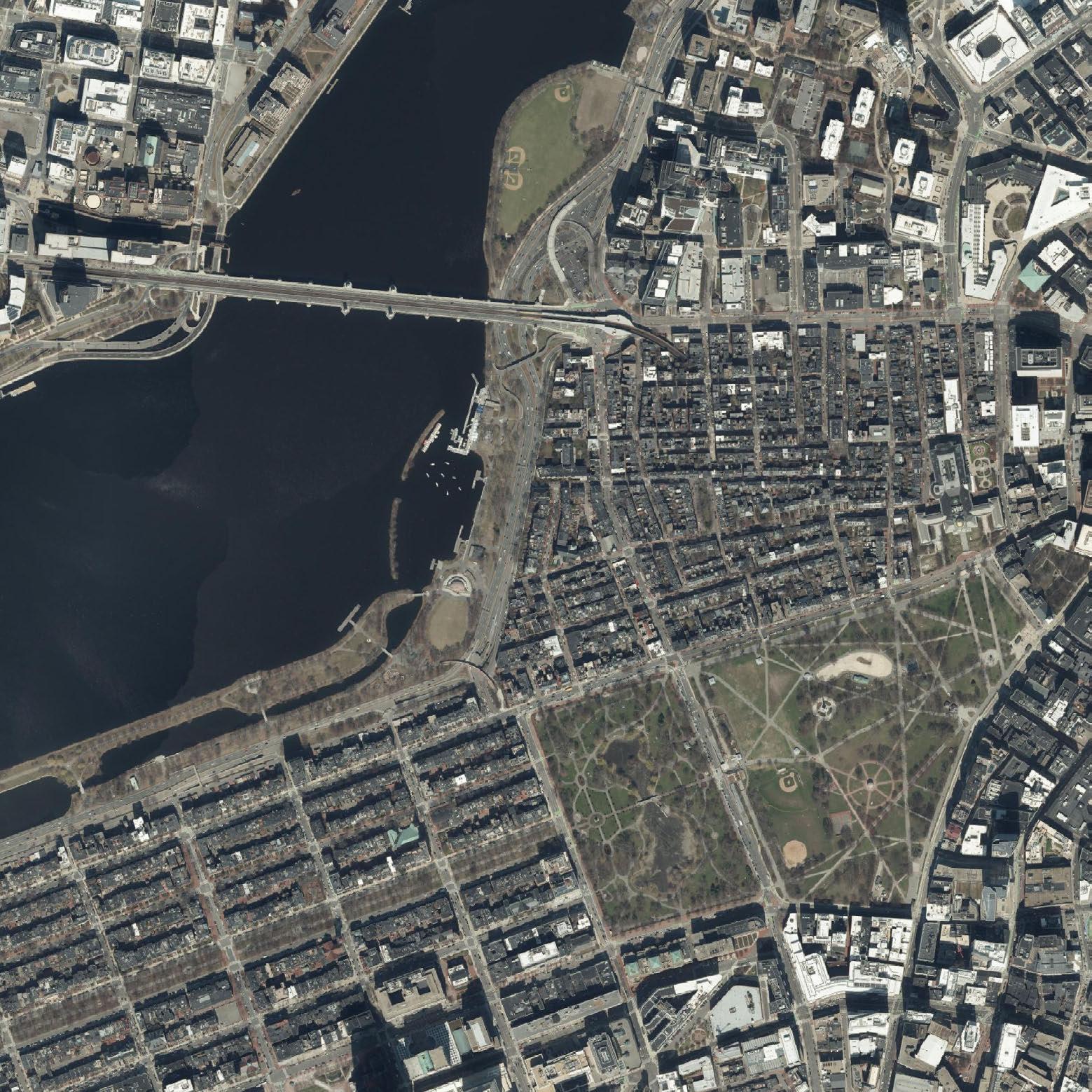
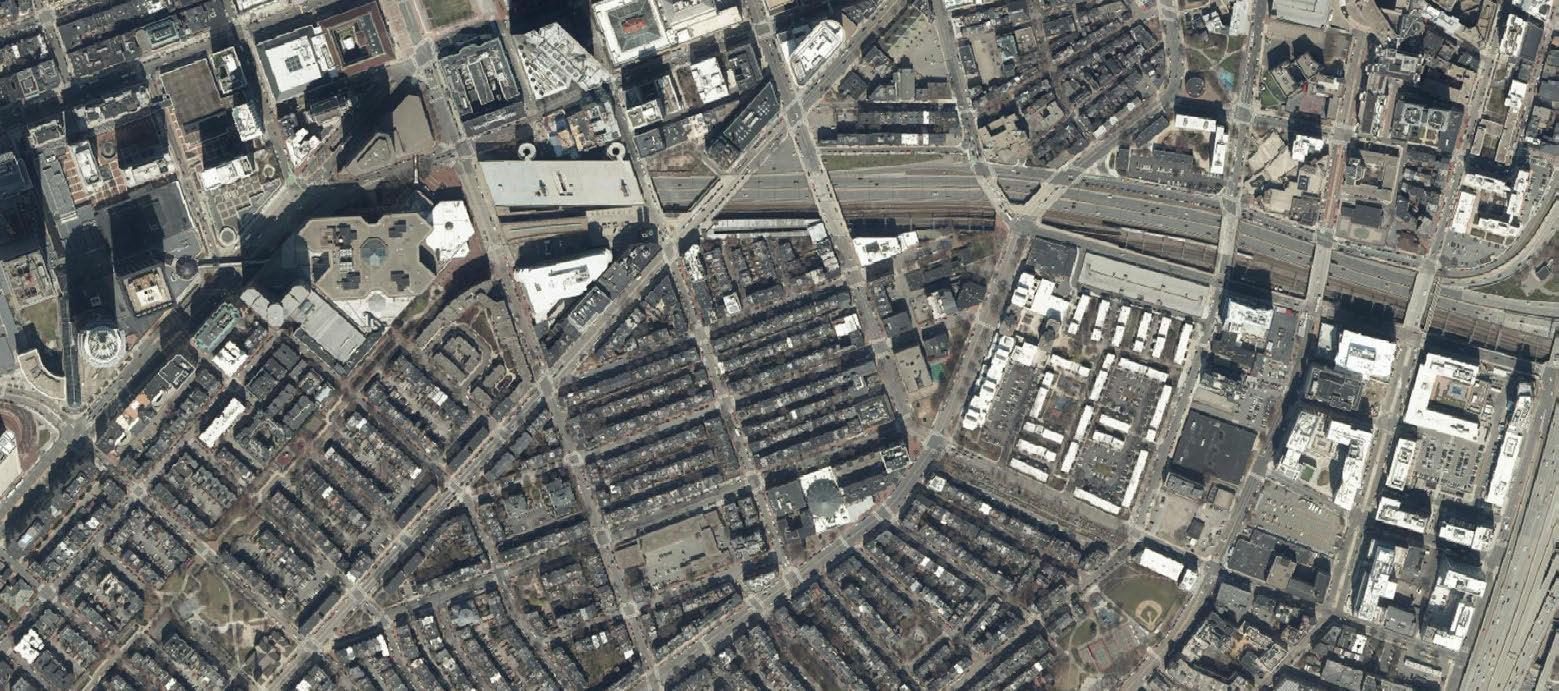
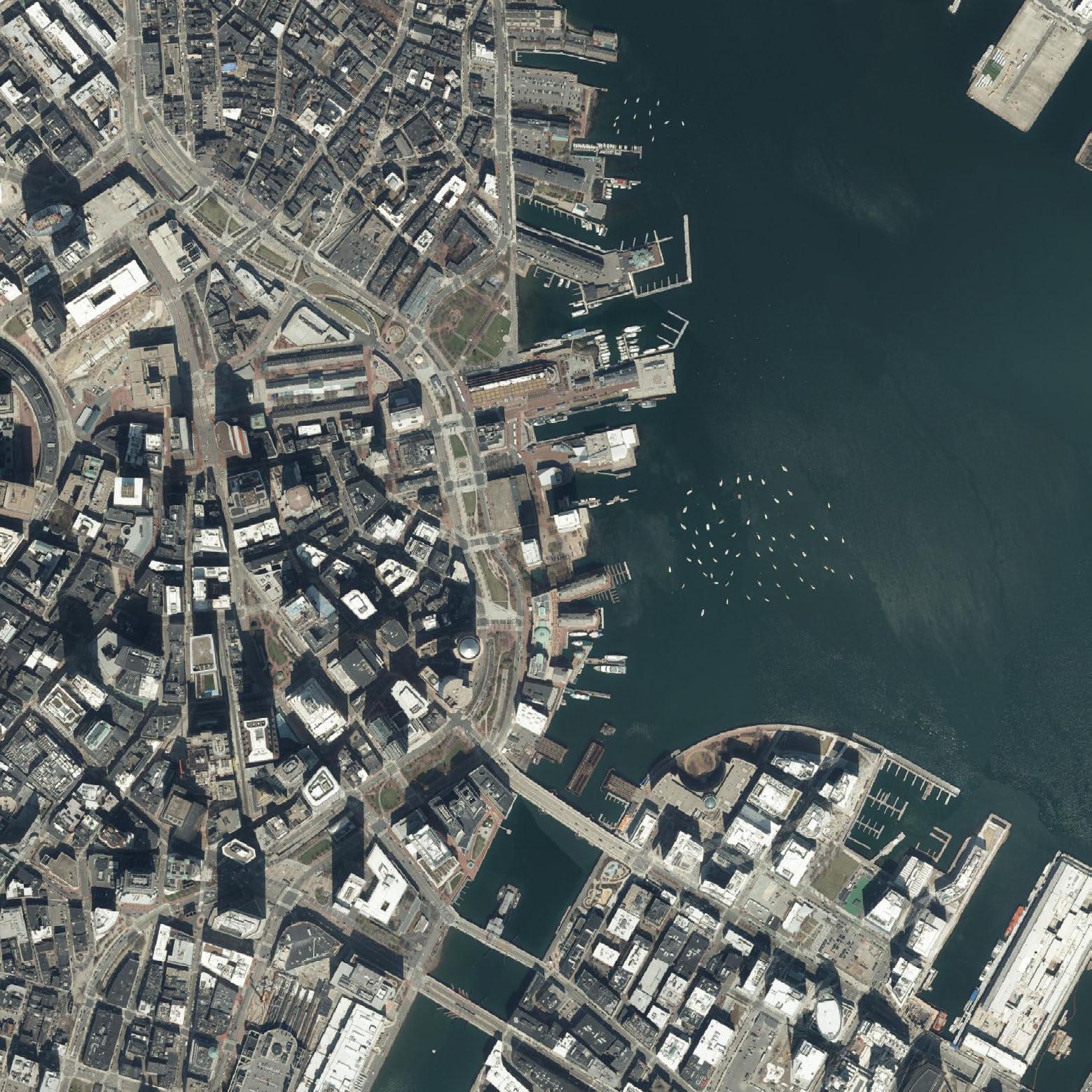
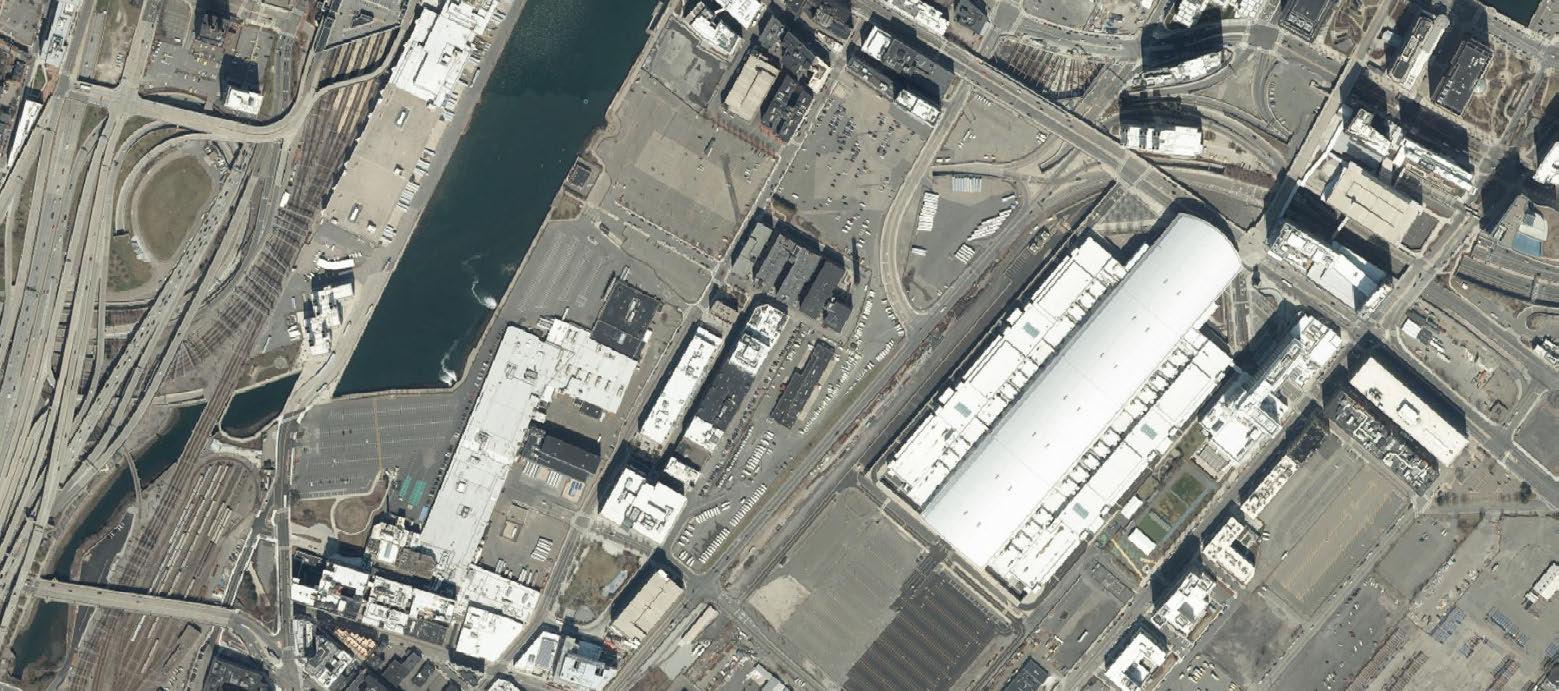
39 Legend open space buildings sidewalks outside neighborhood boundaries Boston landmarks MBTA stations blue bike stations MBTA routes bike routes train routes
design interventions for increased playability
advanced architectural communication | prof. judith rodriguez | spring 2023
Continuing to work with my neighborhoods from the previous project, I was tasked with selecting one of the parks to focus on and suggesting interventions. Although I considered Christopher Columbus Park to be the most playable of those I studied, I found that there were still improvements to be made and its large scale allowed for the greatest flexibility in plan. After careful site analysis, I noted that there should be more of an interaction between the playground and the waterfront, and that the playground did not need to be confined to such a small portion of the site. I chose to add some soft rubber ground covering beneath all of the new playground equipment, as well as a sand play area and some paved space for basketball. Leaving open grass was still very important for my design to allow for running around, but I also wanted to facilitate more organized play and provide seating around the park.
The plan drawing features the alterations I made to the park, including the addition of new play equipment and varied ground surfaces, as well as more seating.

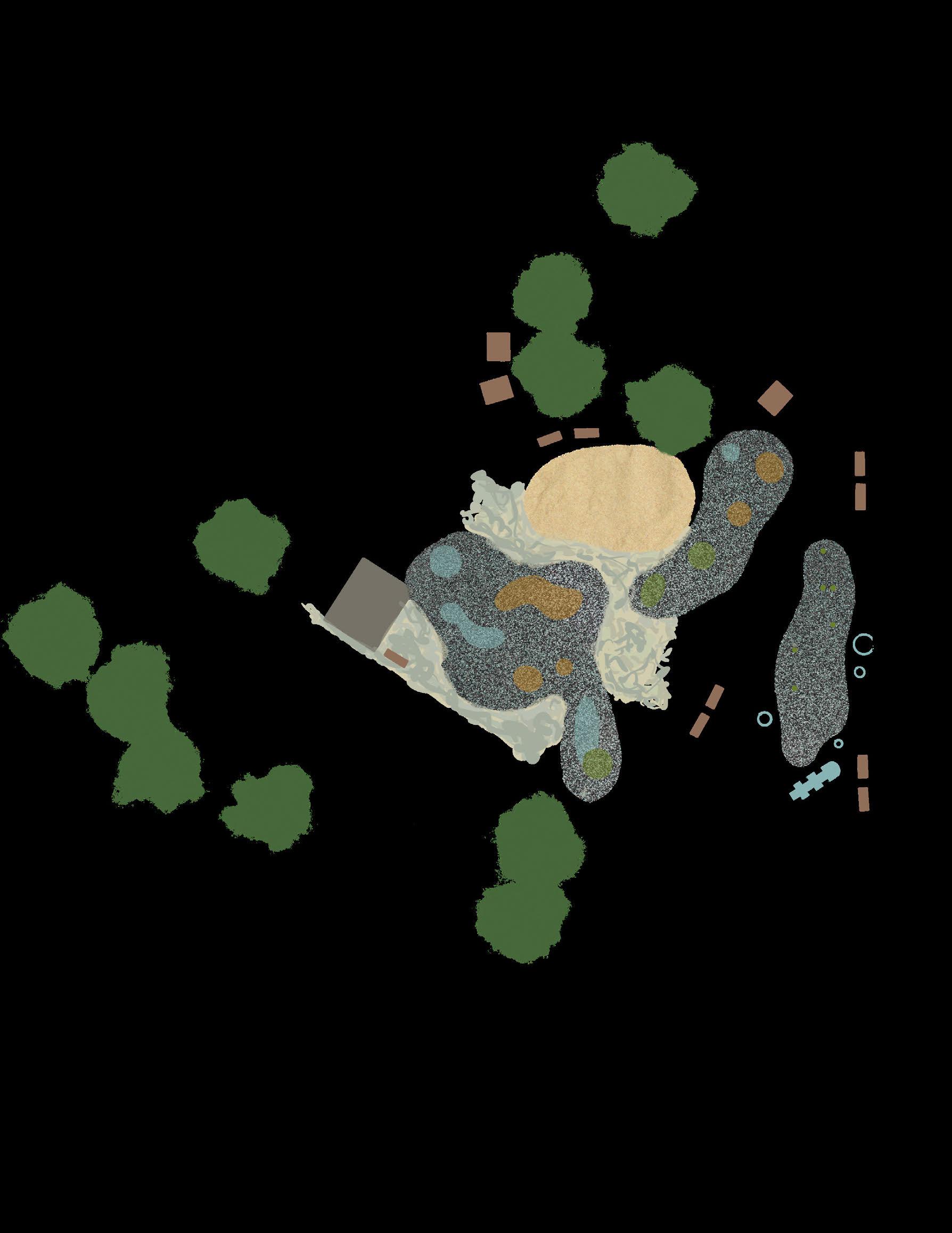
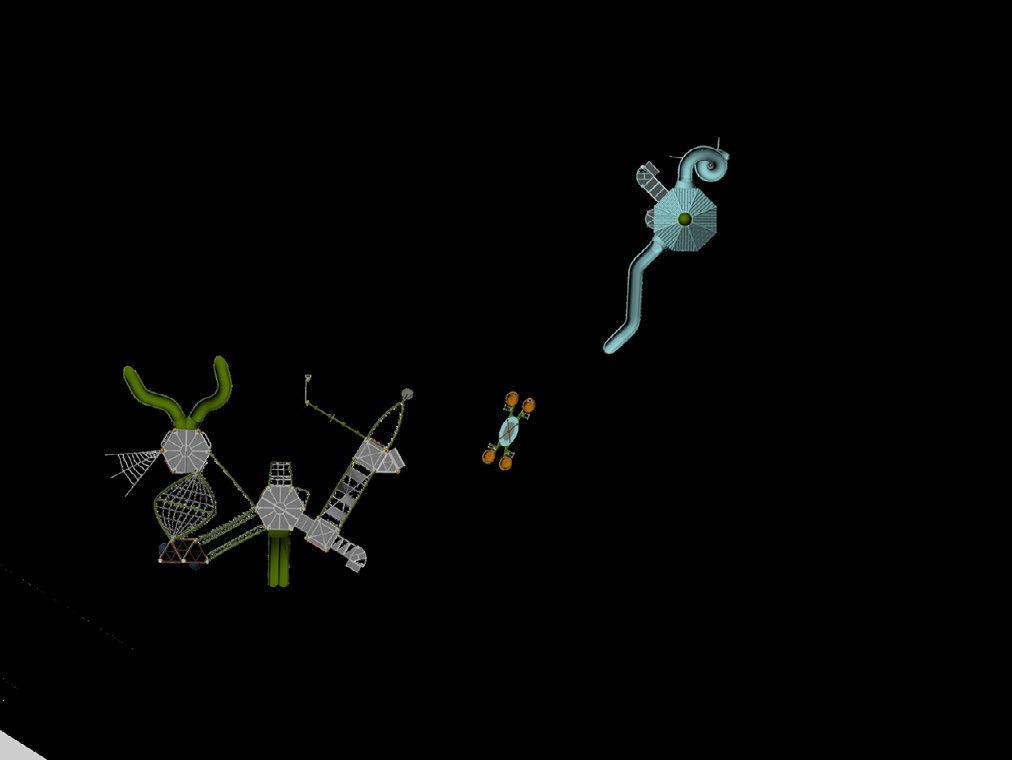
40
These picnic tables are meant to facilitate more group seating, however they are also movable to make room for more play on the grass With the clearance of a couple of trees, left this area as an open greenspace allowing for a variety of activities including soccer This small paved court is inteded to facilitate games such as basketball with friends placed benches across the park to encourage people to spend time there, as well as parents watching their kids I wanted to maintain the use of sand in the park as a ground cover option, but as its own separate play area This tower is element of verticality, situated to look I wanted to develop with the waterfront along water area which also drawing with added a soft, rubber ground cover around all of the play equipment for safety as well as increased playability; it was also an opportunity to incorporate more color Taking student feedback into account, made sure to choose a large playground structure that incorporated slides also made sure to include several climbing elements across the park including this wall here and both the monkey bars and netting along the waterfront The students mentioned they hoped for a working seesaw and more swings, both of which have proposed in this plan





This axonometric depicts the layout of all the new equipment and ground coverings, while the rendering below is one of four built upon photographs of the original site to envision the increased playability of the site with the new changes.
41 meant to provide an verticality, and is speci cally look out over the waterfront develop a stronger relationship waterfront incorporate more play promting me to design this also encourages small games and with chalk on the stone paving

























































































































































